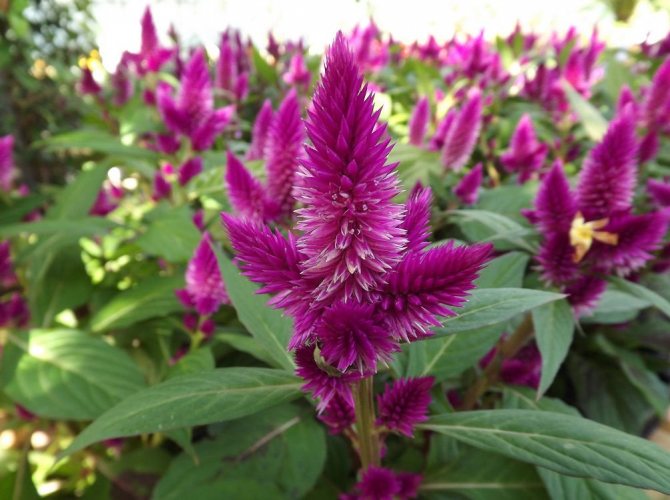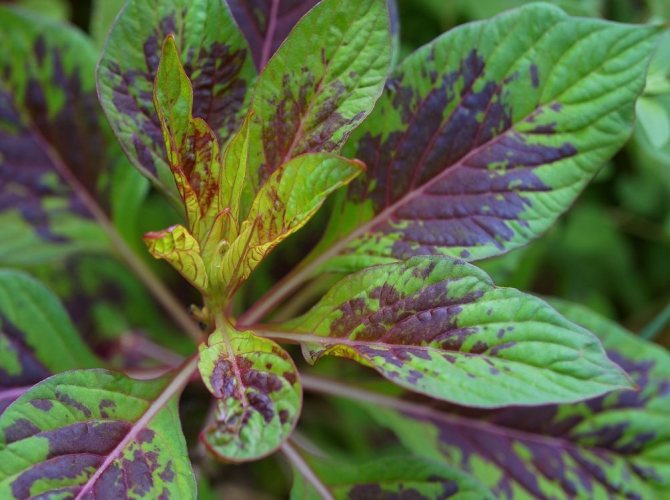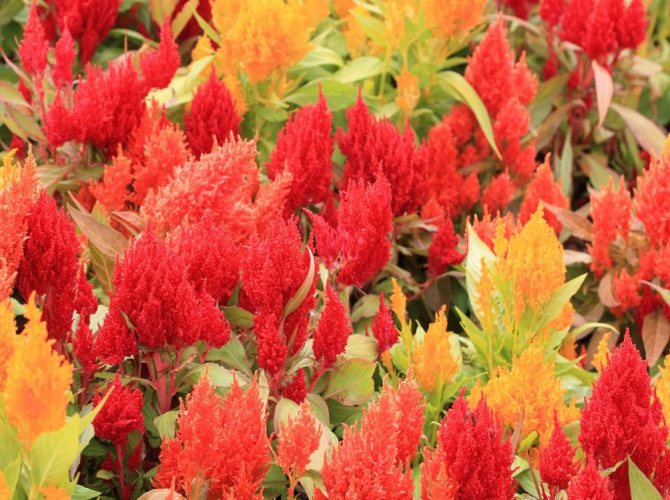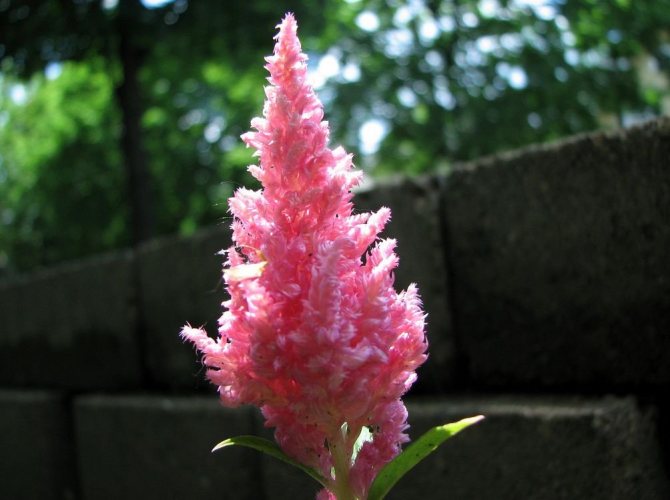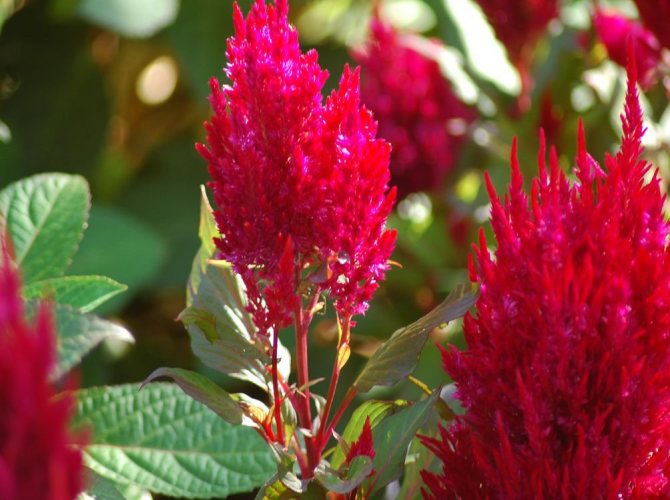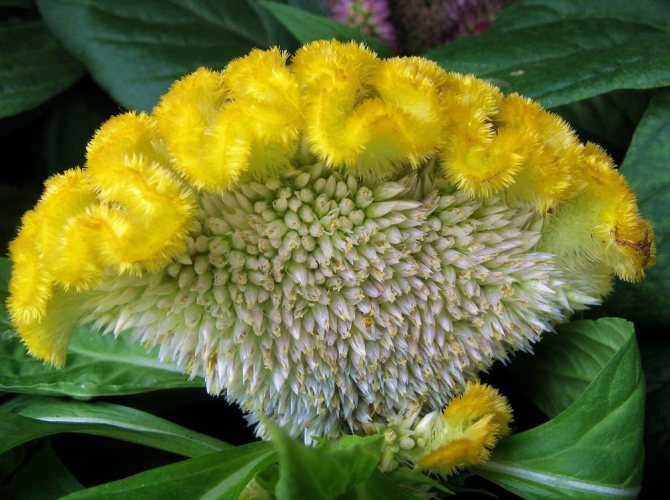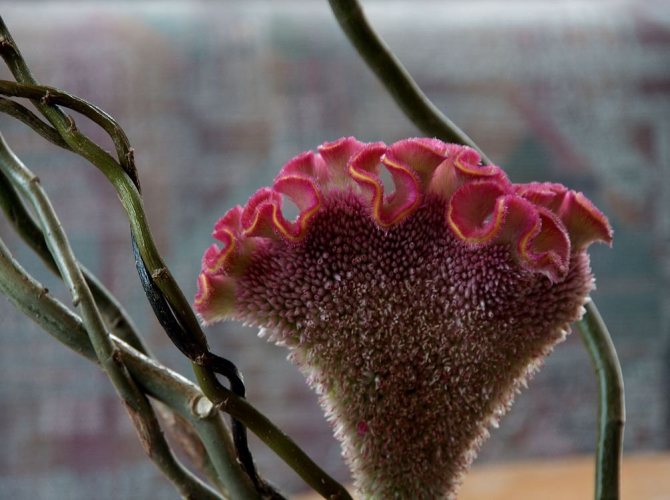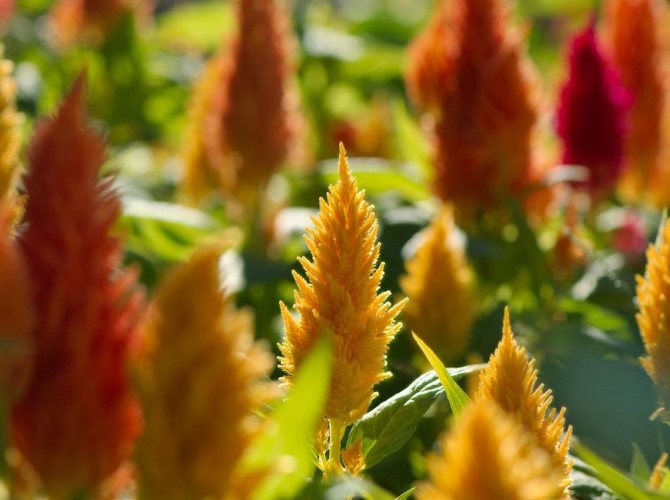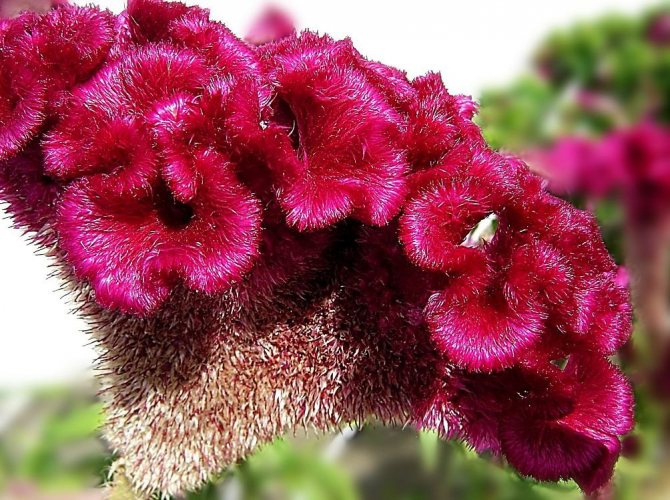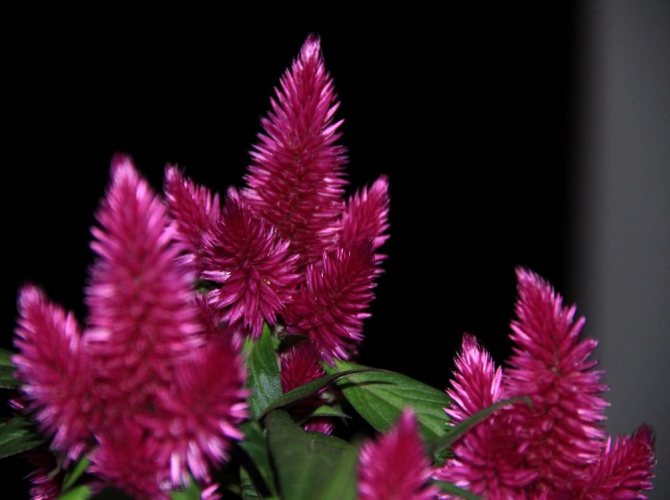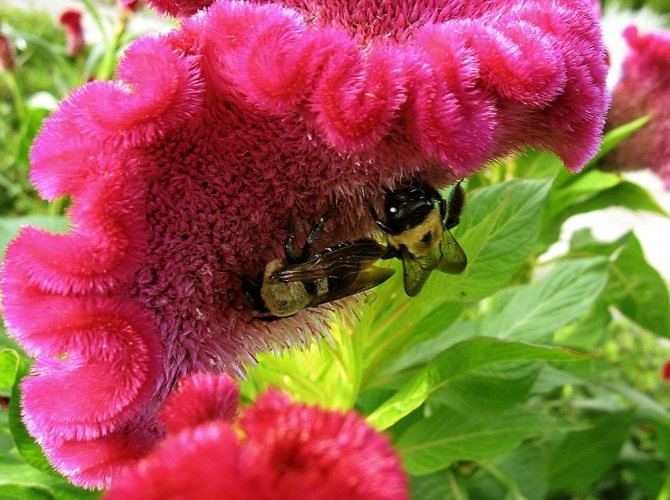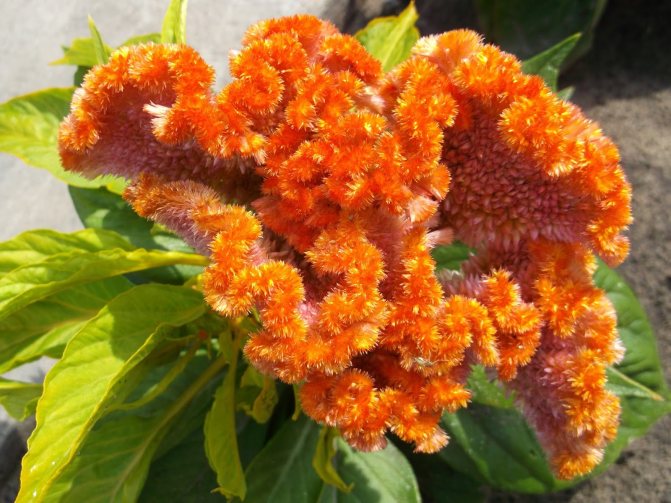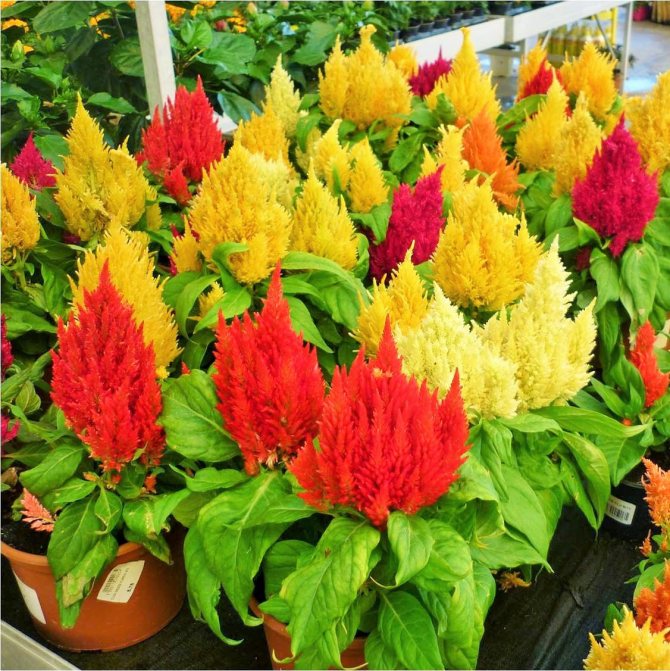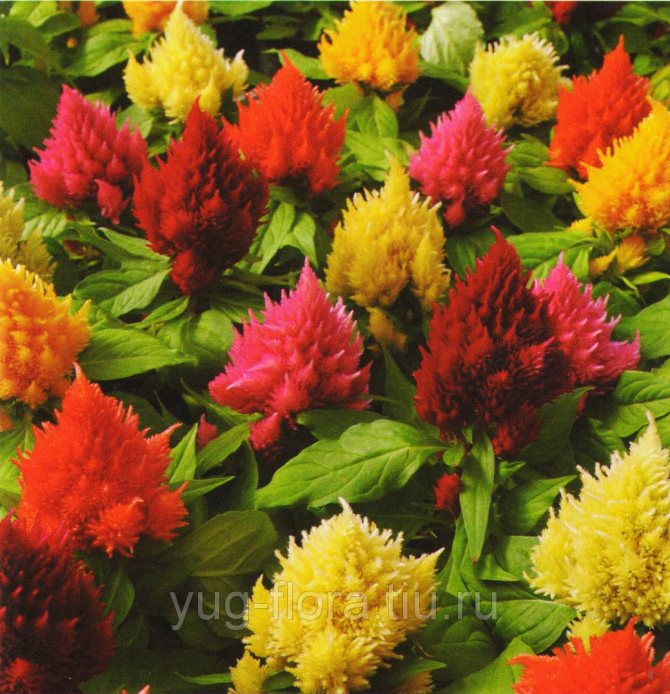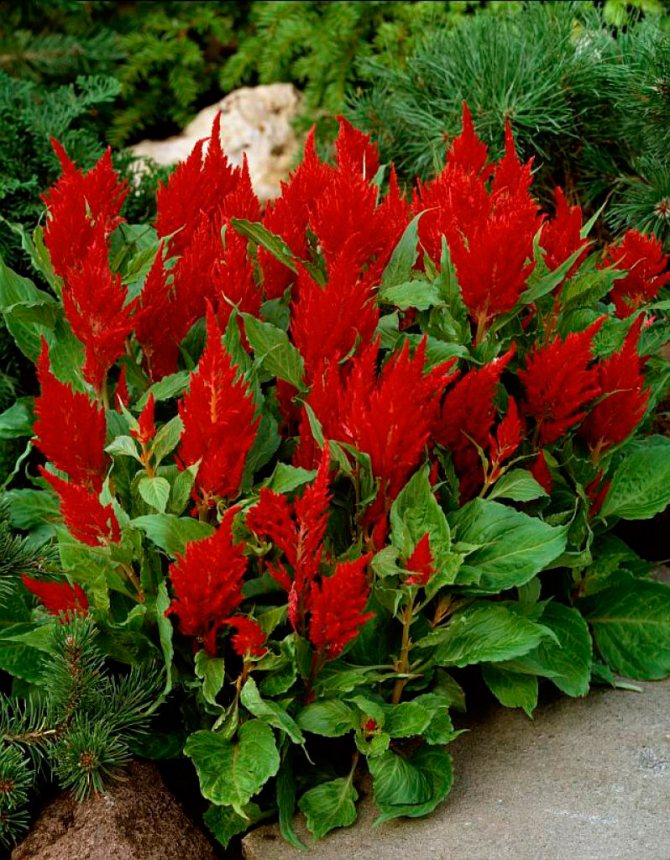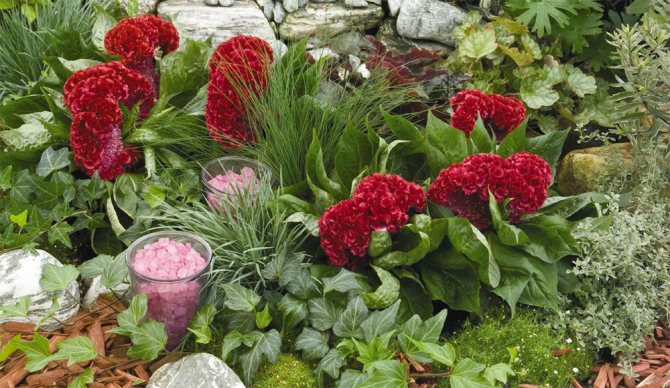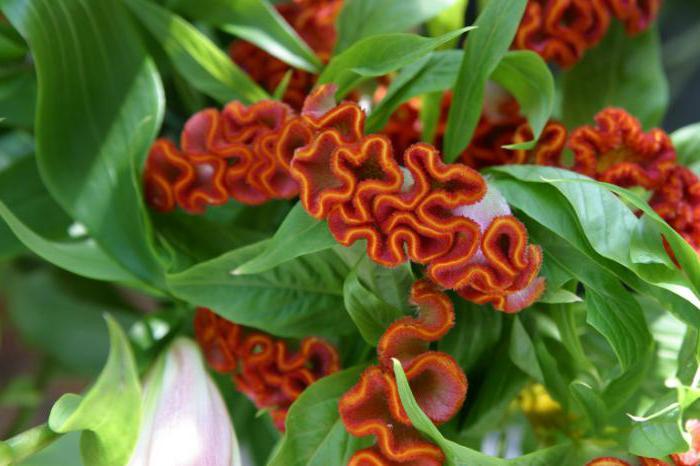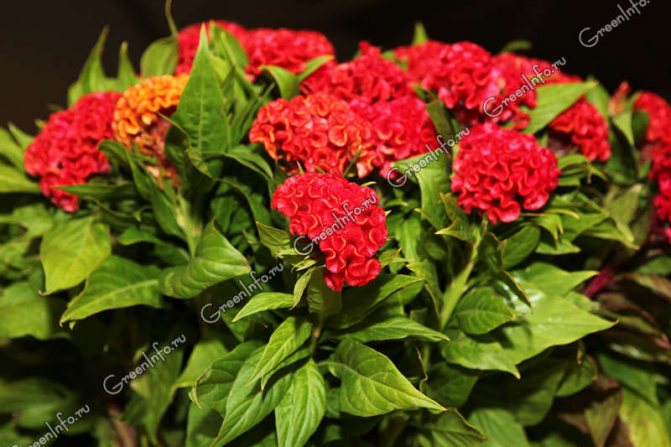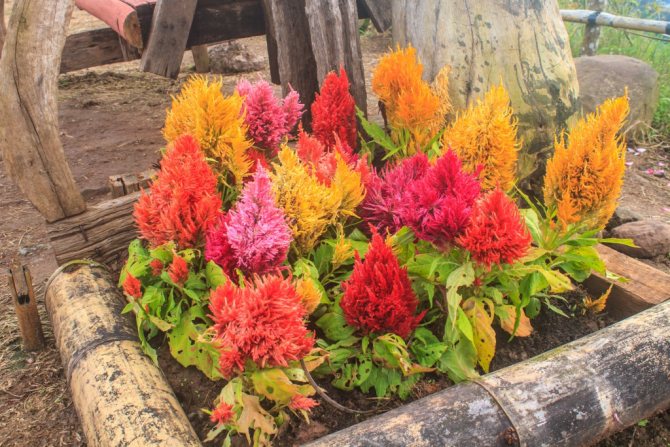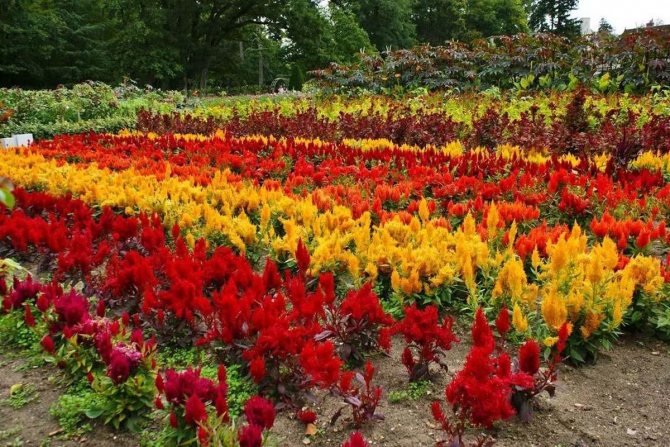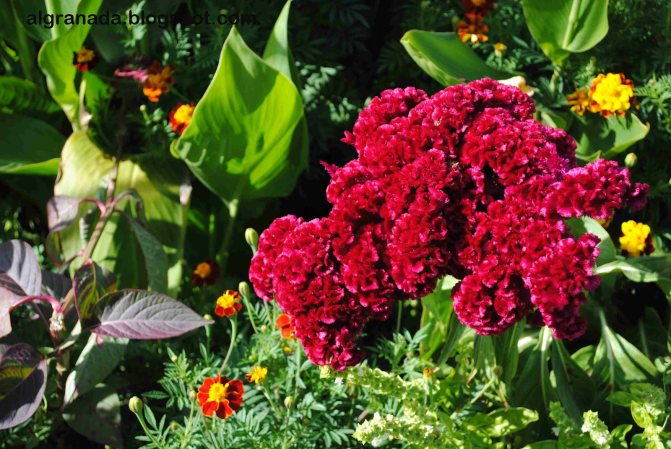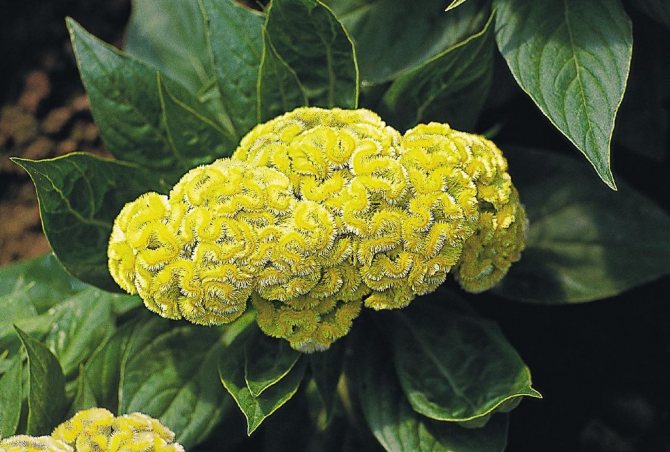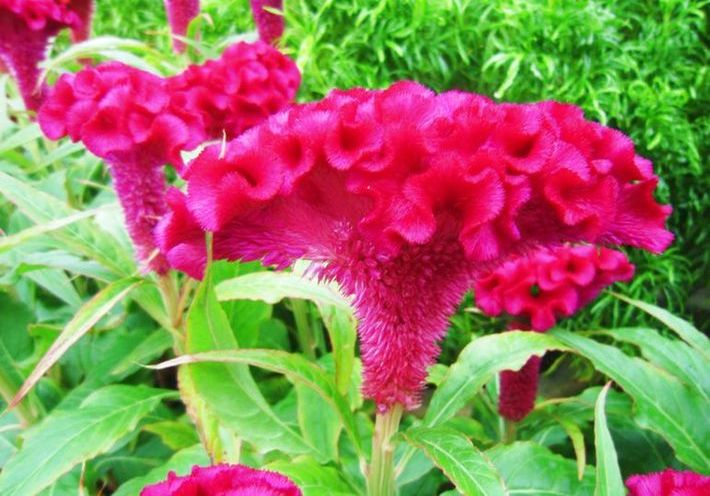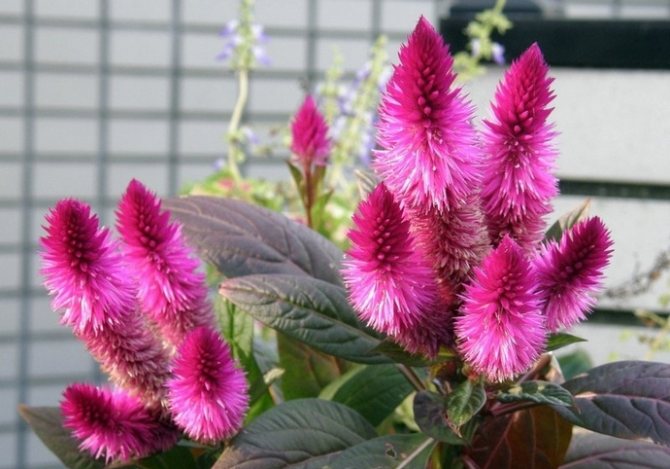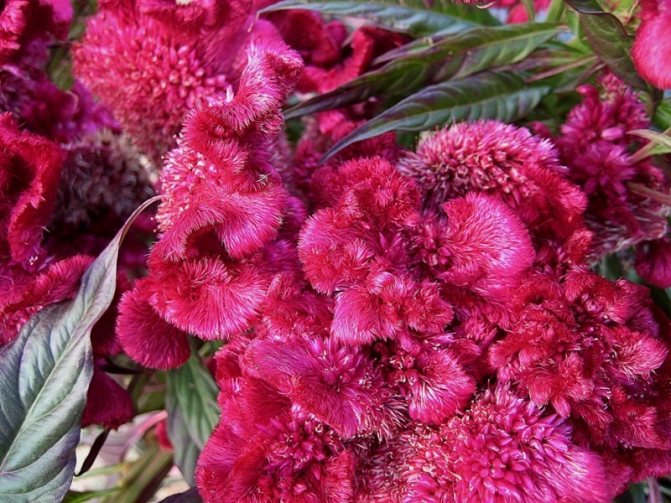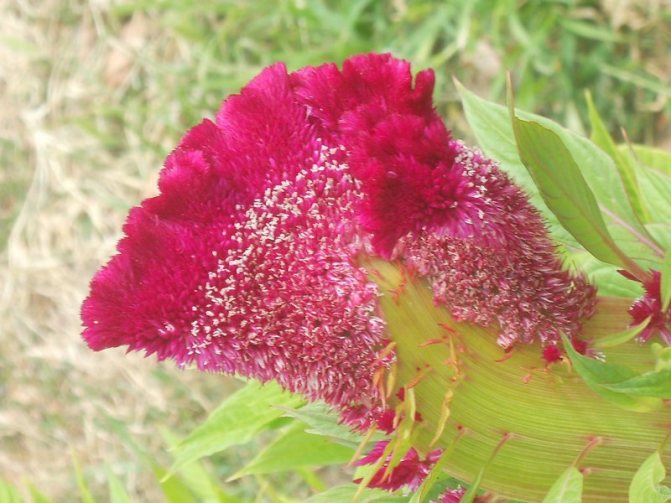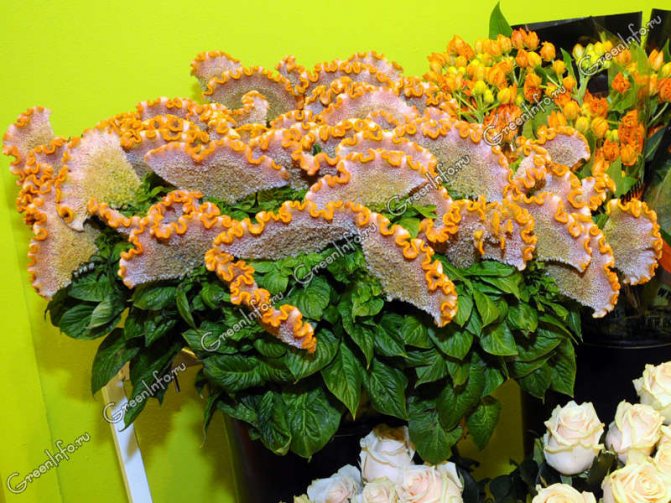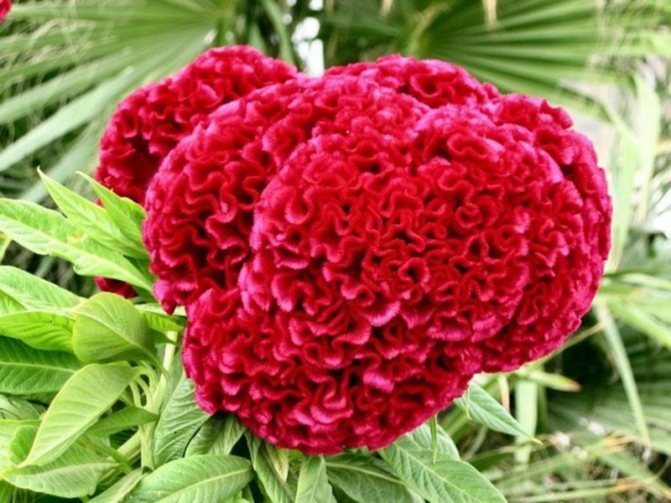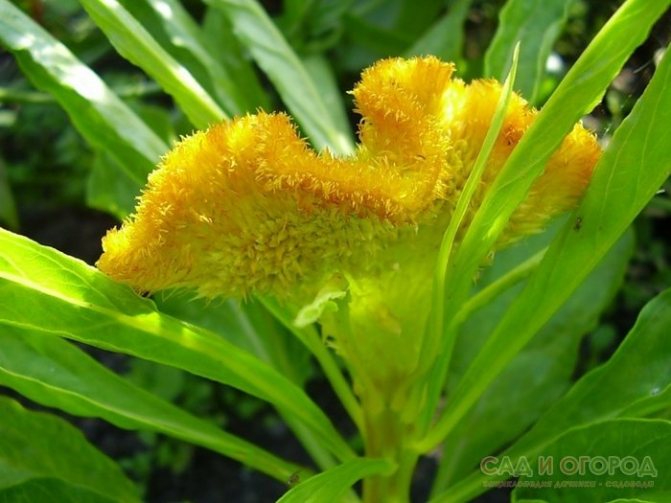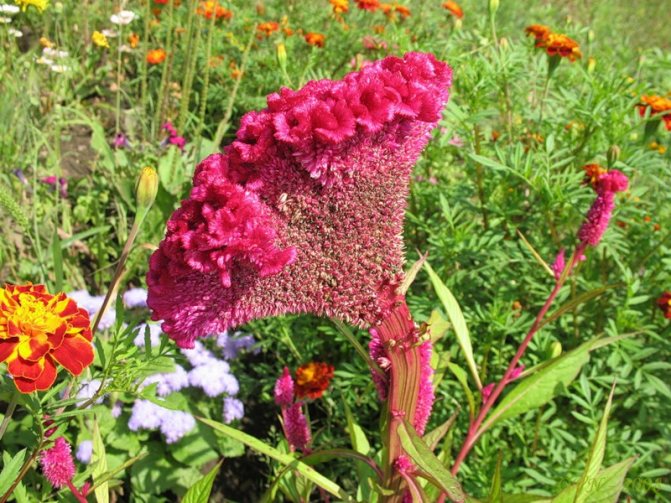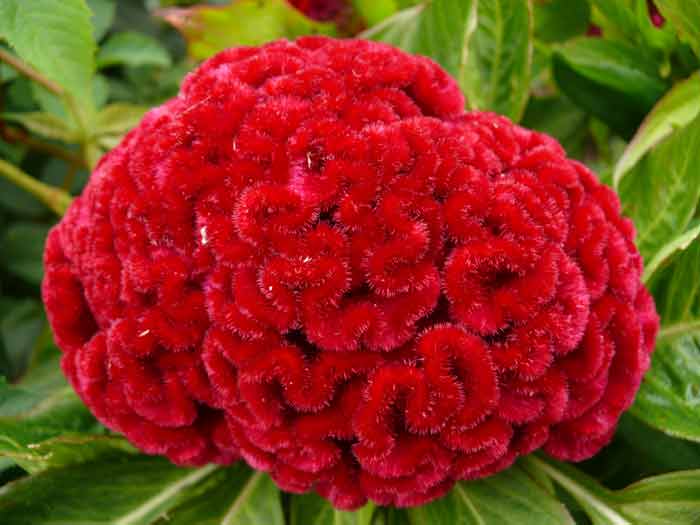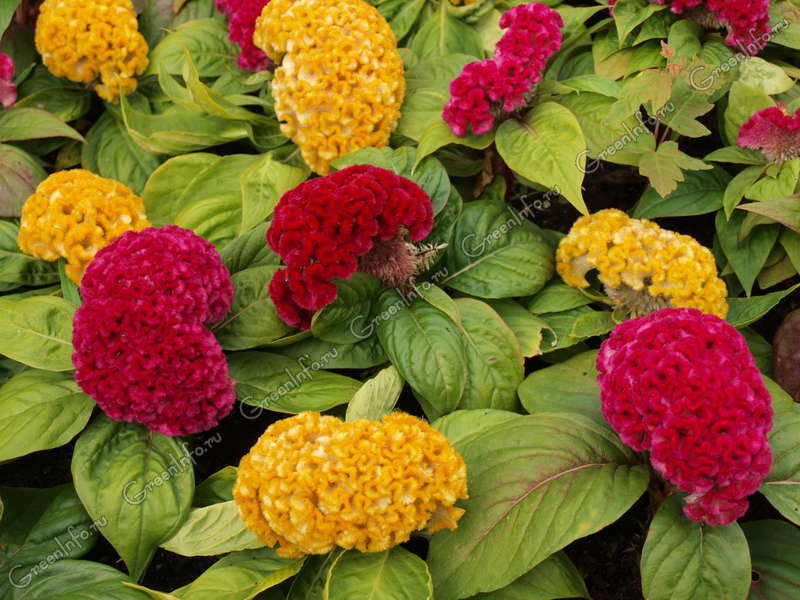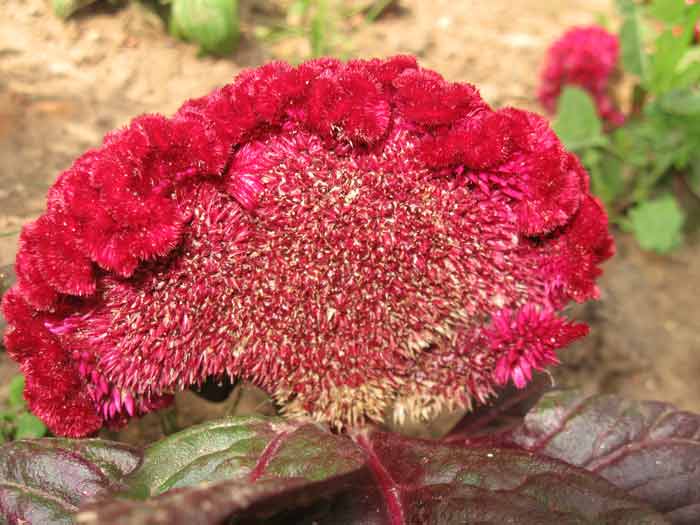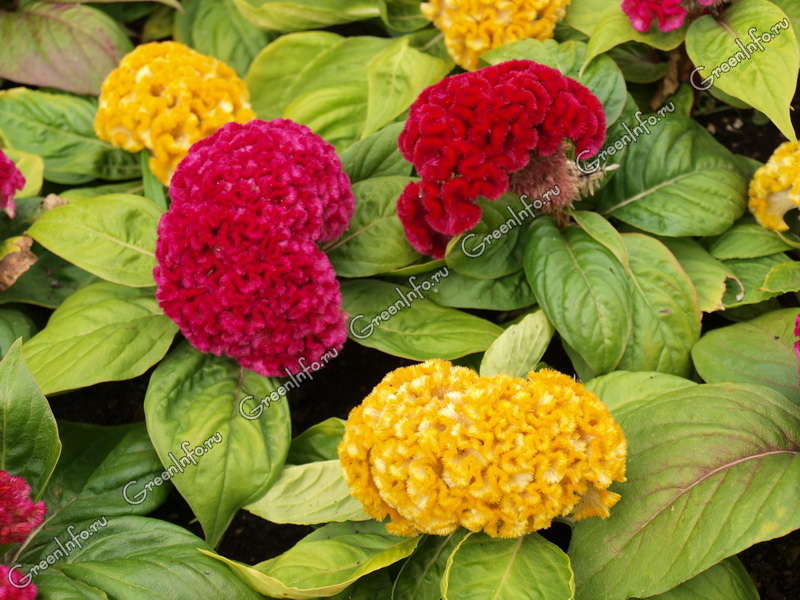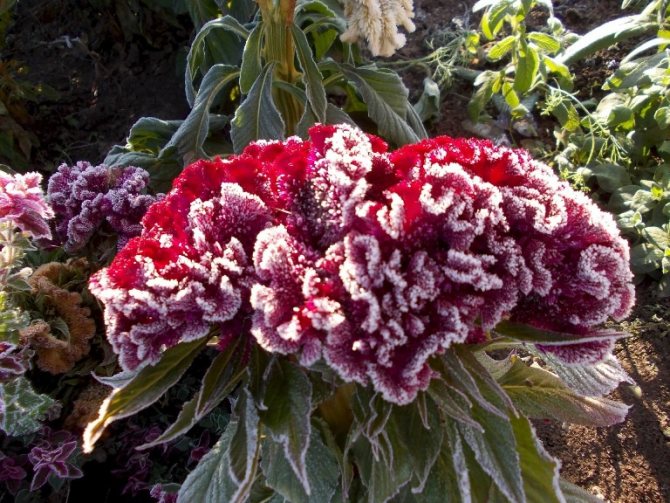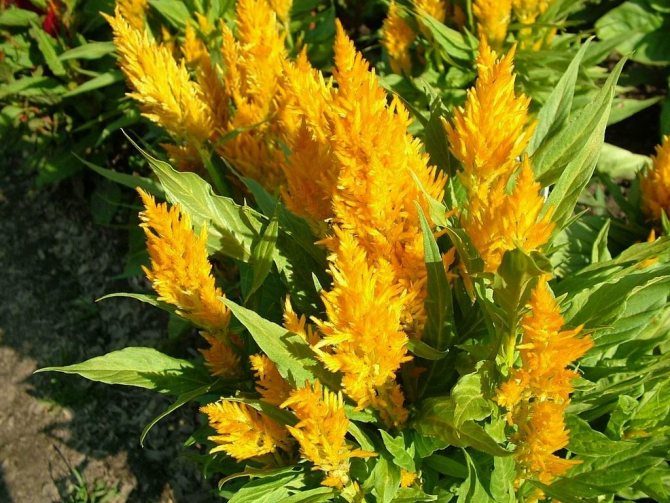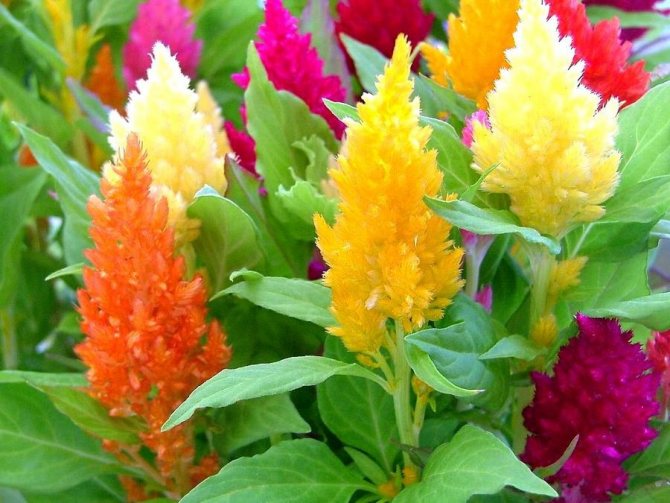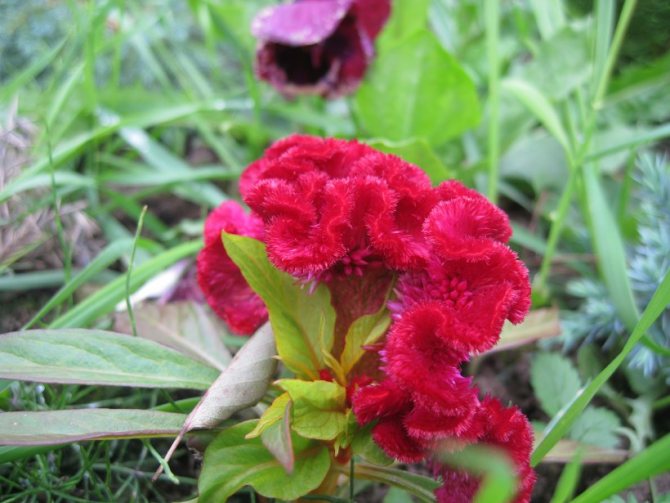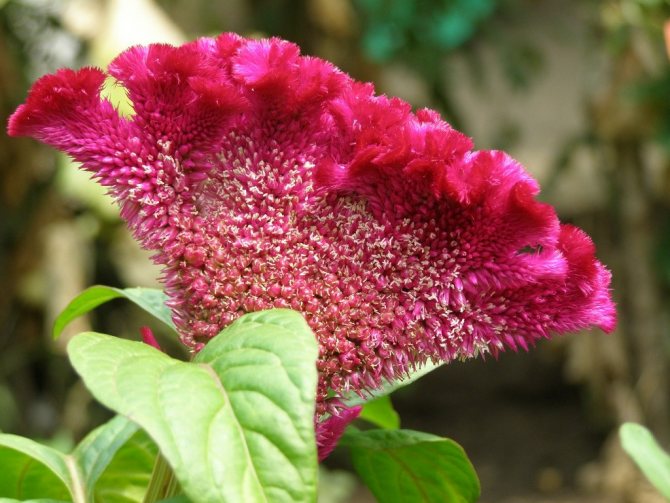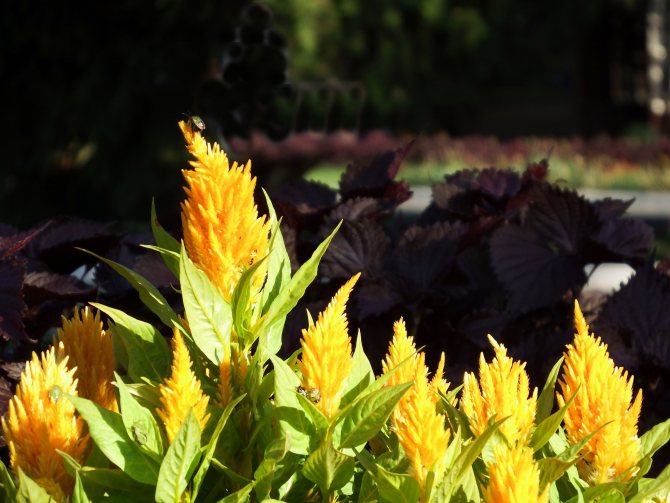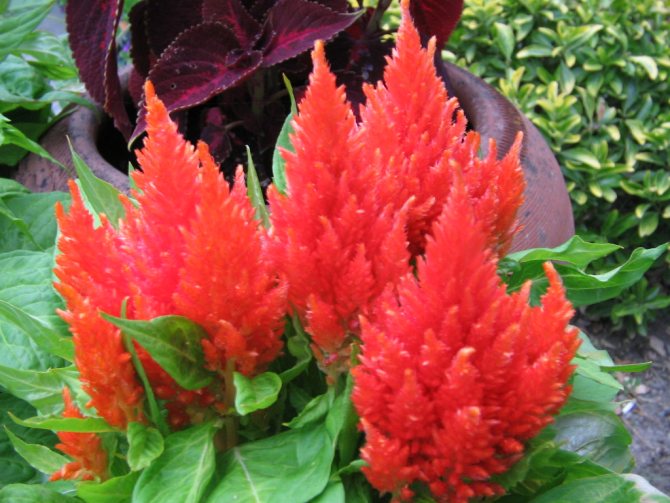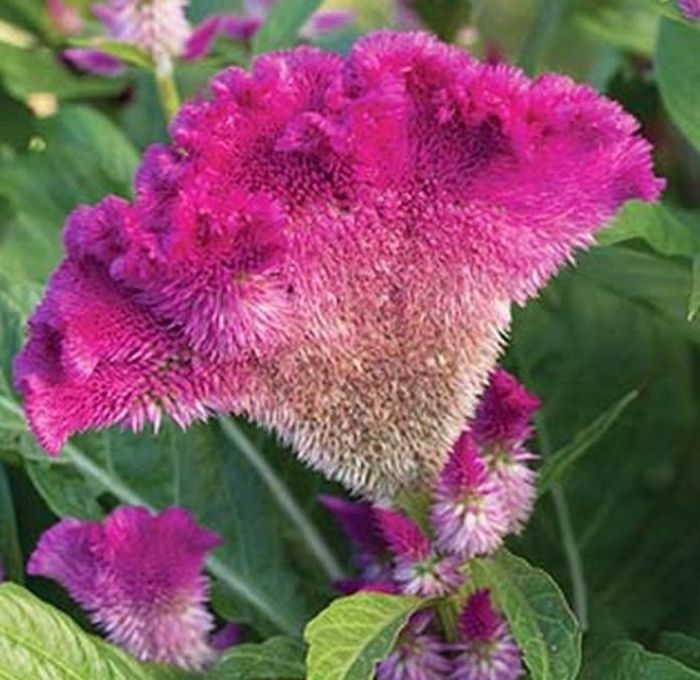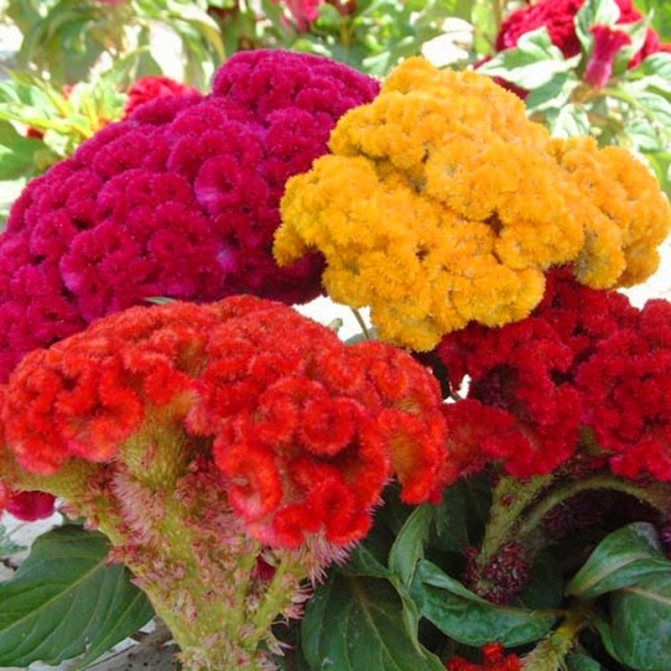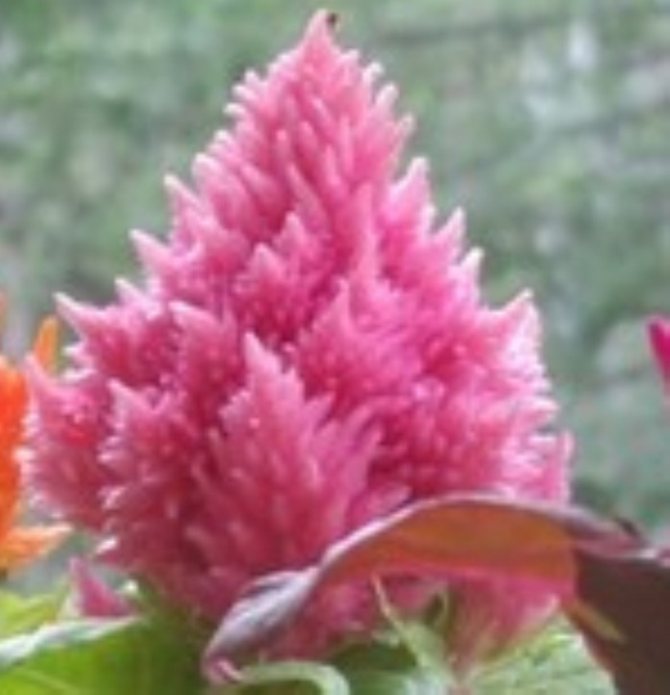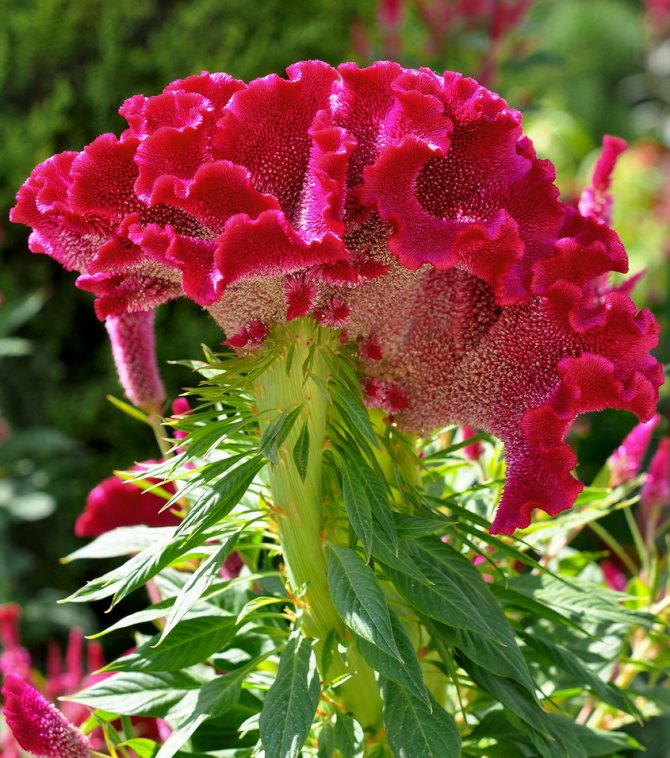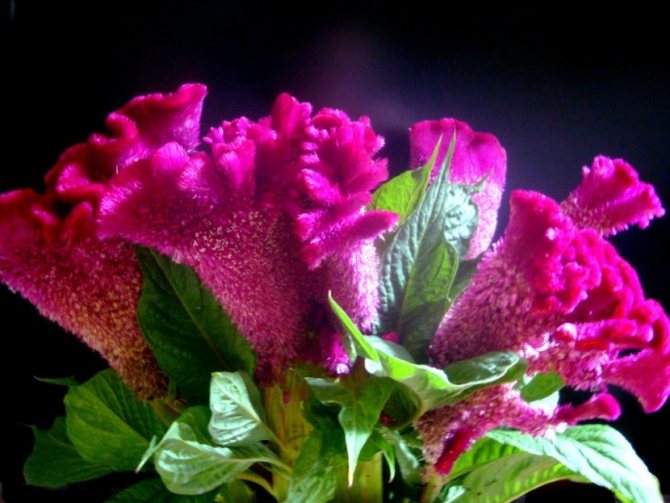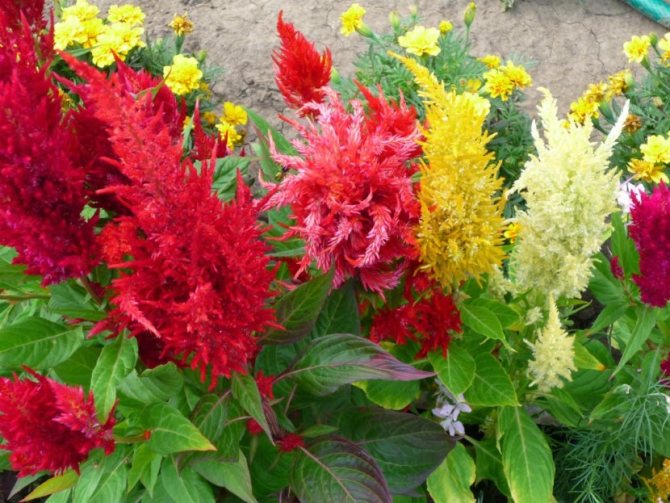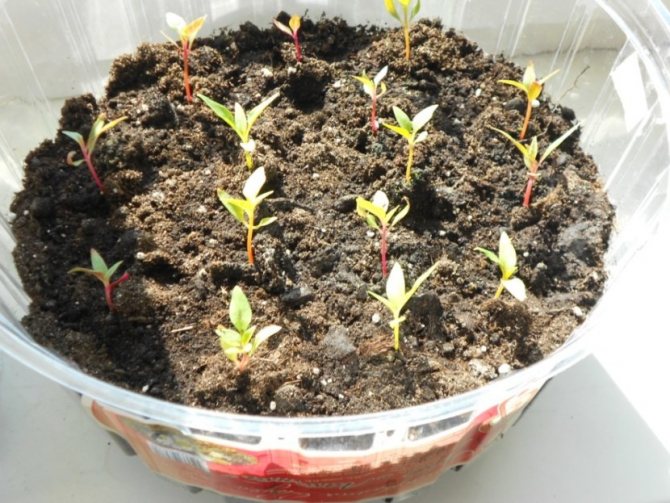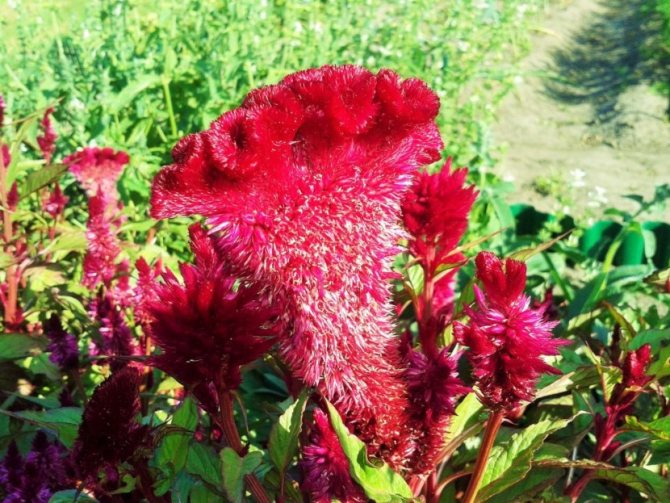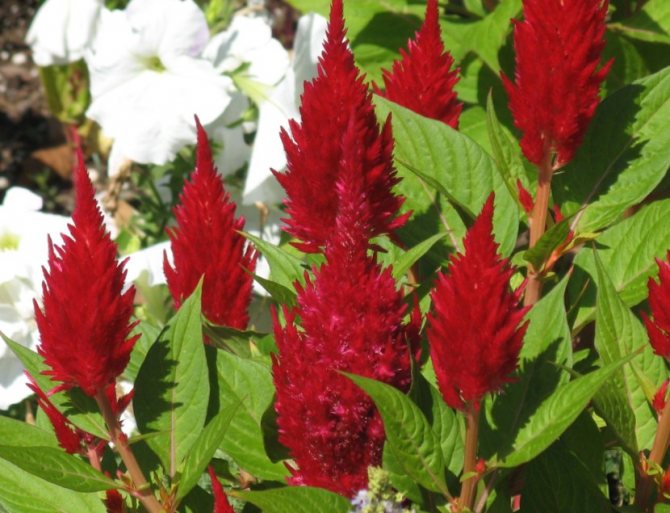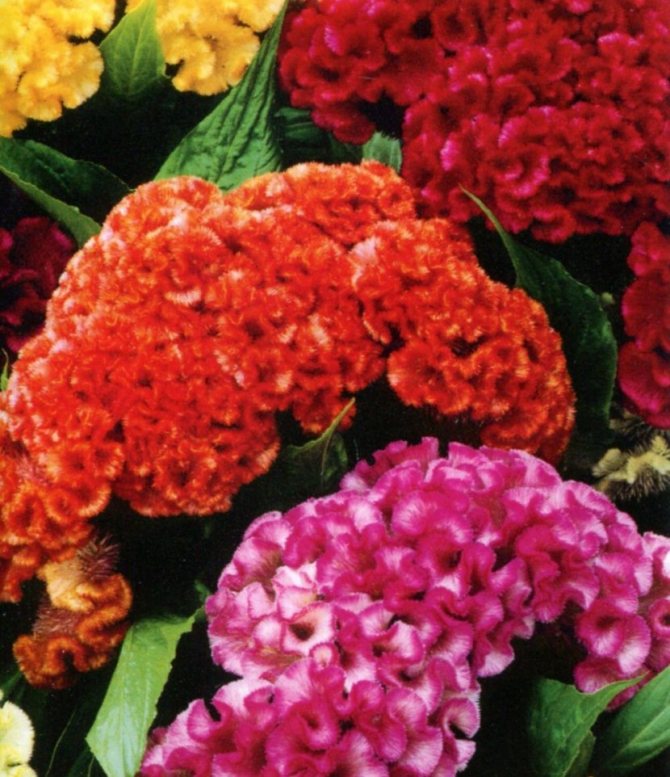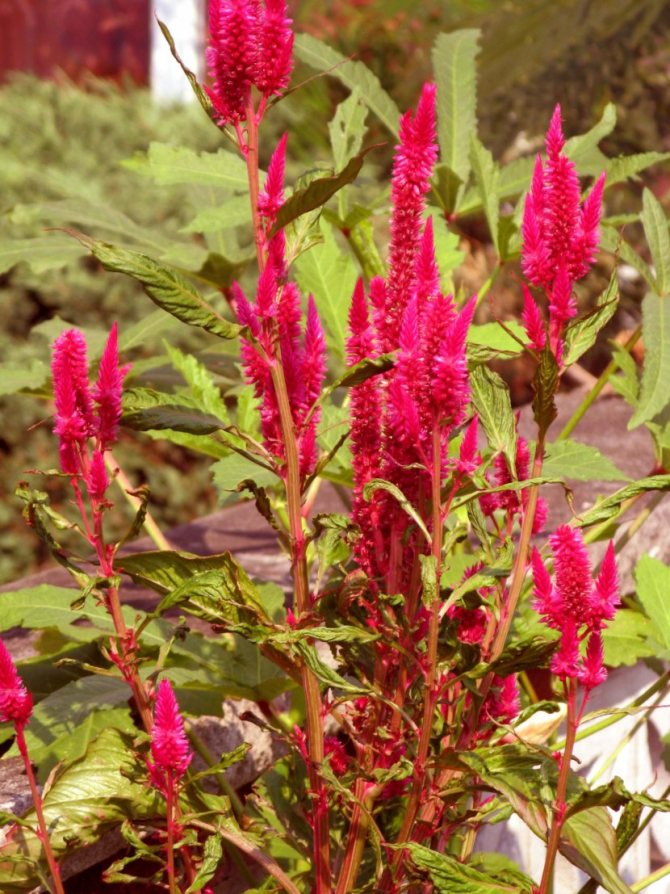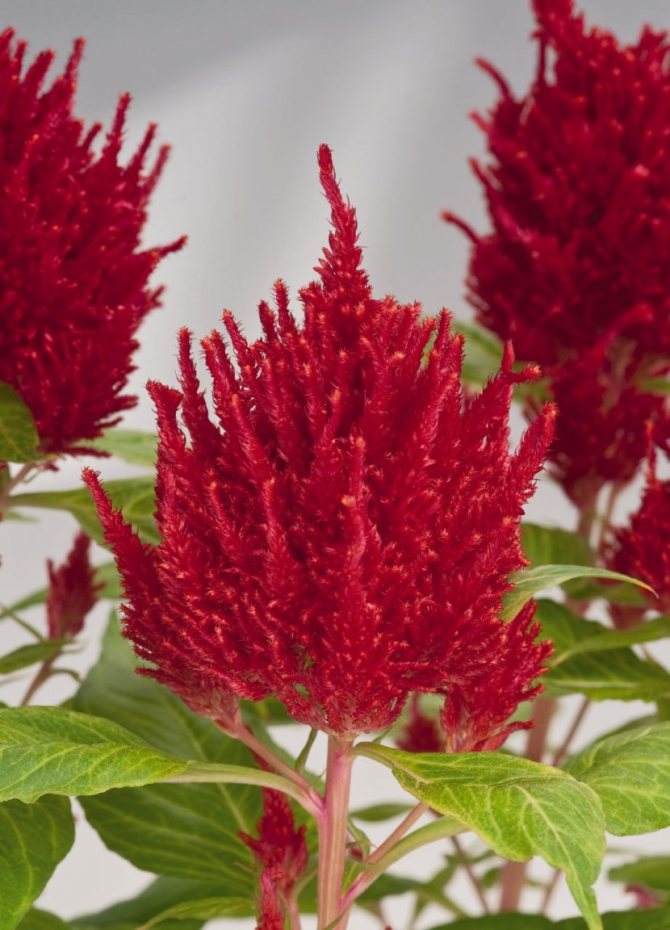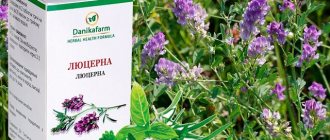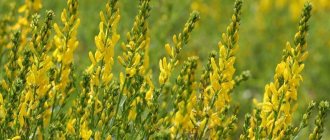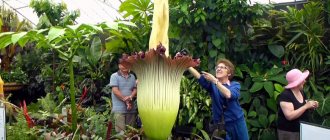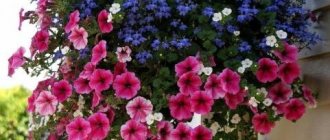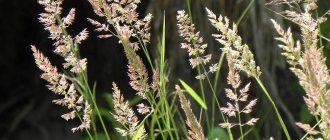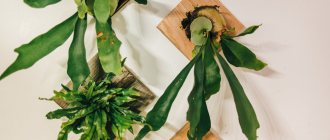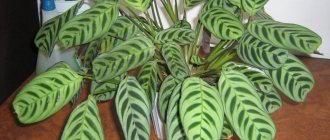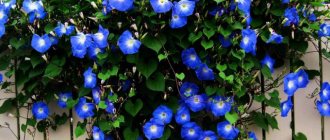Crested Celosia is an annual plant that has a very bright and attractive flower. It can be grown both indoors and on your own backyard. If a florist has decided to grow this plant, then he should certainly know about some of the intricacies, as well as familiarize himself with some of the features and characteristics of this culture. Also in this article we will dwell on the description of the caring characteristics of the planting, on what is necessary for cellosis in order to demonstrate the maximum of its decorative effect.
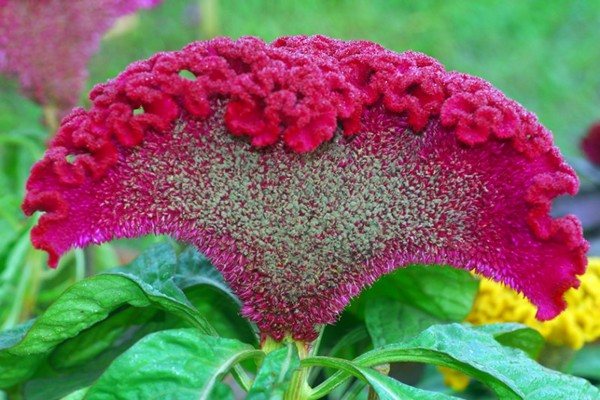
Care and cultivation of room cellosis
Flower pots are placed in a room where the plant will have access to sunlight. But direct sunlight is harmful to the plant, so the light must be diffused. The optimum air temperature for a room temperature is 14-18 degrees. When the air temperature rises to more than 25 degrees, the room is ventilated. Water the flower with water at room temperature. When watering, it is advisable not to allow water to get on the flowers of the plant. The soil in the pot should always be moistened, but the soil should not be overmoistened. From time to time, the leaves of room cellosis are sprayed with water. Indoor celosia is fed every two weeks with mineral fertilizers (not nitrogen). Yellowed and damaged leaves of the plant are promptly removed. After flowering, the plant is discarded, but some growers grow the flower as a perennial houseplant.
Planting seedlings in the ground
As we have already noted, celosia is a heat-loving plant, therefore, seedlings should be planted when the possibility of frost is completely excluded.
What do you need to consider when landing? First of all, we choose the right place. Warmth and sunlight - this is what the flower loves, do not forget that he is afraid of drafts. Fresh organic matter cannot be introduced. The soil should be loose and nutritious, not acidic.
- To avoid stagnation of water and the resulting rotting of the root system, drainage is laid at the bottom of the holes.
- Seedling roots break very easily, therefore, peat pots can be left on. If the seedlings grew in ordinary containers, the earthen lump is preserved.
- The recommended distance between holes is 20 cm, but if the varieties are tall, it can be 30 cm or more.
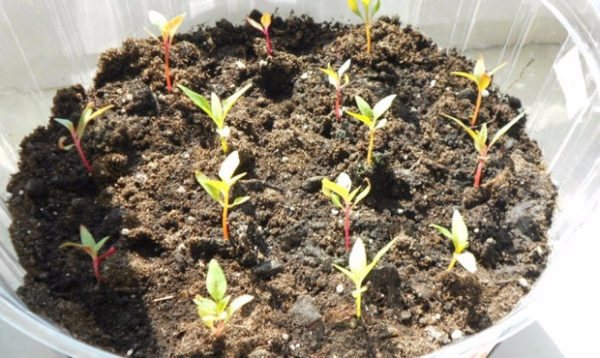

Diseases and pests
Celosia is susceptible to such a disease as black leg. The pest is aphid.
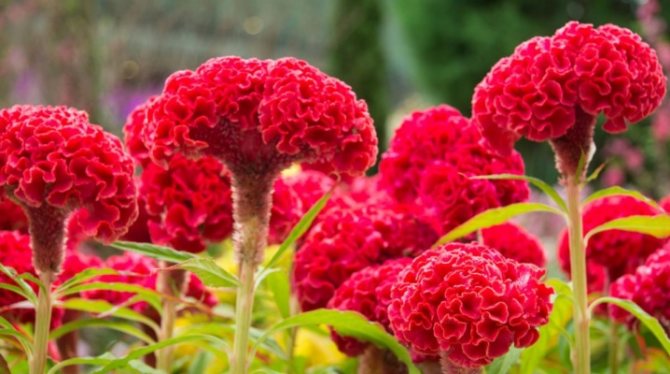

Celosia comb is a bright annual flower that is successfully grown both in summer cottages and at home. The name of the culture comes from the Greek kelos, which means "fiery, blazing". If your choice fell on this interesting plant, and you want to grow it yourself, you should familiarize yourself in more detail with the characteristic features and nuances of crop care.
We take care of seedlings
Caring for seedlings is not difficult - it consists in regular watering and loosening the earth. You will also need to take care of the lighting, including the lamp for five to six hours. Top dressing will not be superfluous, you can use complex mineral solutions for flowering plants.
When two pairs of leaves are visible on the seedling, a pick is made. The seedlings are transferred to other containers filled with the same soil.
The second time a pick is made when the seedlings get stronger and become larger.
Description
Cockscomb in another way is called cockscomb. The name came for a reason, since the inflorescences are, indeed, very similar to bright rooster combs. The plant belongs to the amaranth family, is grown as an annual because it does not tolerate frost. In a natural habitat, the height of a celosia is about 45 cm, but in a home or garden, the culture rarely grows above 30-35 cm.
The flowers of the plant are small in size, gather in large inflorescences in the form of scallops. The colors are represented by almost the entire warm range of colors: yellow, orange, red, hot pink, crimson.
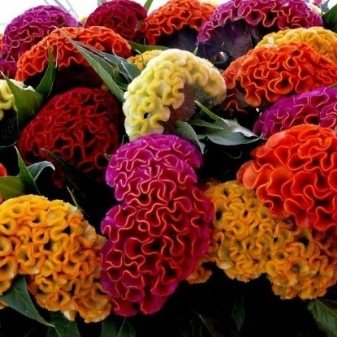

As for the fruits, these are small boxes containing seeds. Their gardeners use them for the subsequent cultivation of crops. The plant begins to bloom in July and ends in mid-October.
If we talk about interesting facts related to cezion, then it can be noted that the peoples of Africa widely use this plant for food... Culture and medicine are also used: decoctions from the leaves of rooster combs successfully fight many inflammatory processes in the body.
Watering and lighting a mini greenhouse
Be sure to water the seedlings, it is better to moisten the soil by spraying. Some gardeners advise watering in the morning so that the water evaporates during the day. But watering in the evening, especially with warm water, is not recommended. Excessive watering leads to rotting of young roots, so it is better to underfill than overflow.
Remember that celosia is a guest from a warm country, where it is almost never cold. It needs a lot of light, slightly acidic soil with good drainage. The plant does not tolerate stagnant water. If you forgot to drain, then you need to take care of the bottom outlet. These can be holes in a pot, in a glass or in a box.
You can find out more about the landing rules by watching the training video.
Common varieties
Consider several varieties of crested comb, which are most often chosen by gardeners.
"Impress"
This is a plant with light green leaves and airy inflorescences. The color ranges from burgundy to bright scarlet. The height of the culture is no more than 25 cm.
"Empress"
Another popular undersized variety, the height reaches 30 centimeters. Scarlet veins are clearly visible on the leaves, and the buds have an attractive purple color.
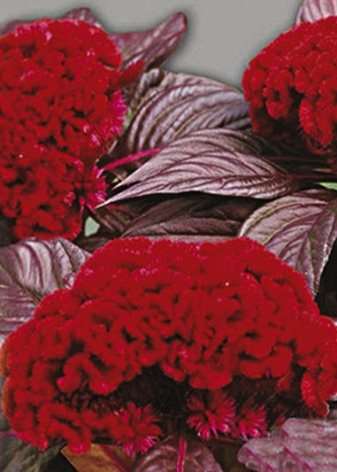

"Atropurpurea"
Celosia with huge, very heavy, bright inflorescences. The stem is pink and the leaves are light green. Height - about 20 cm.
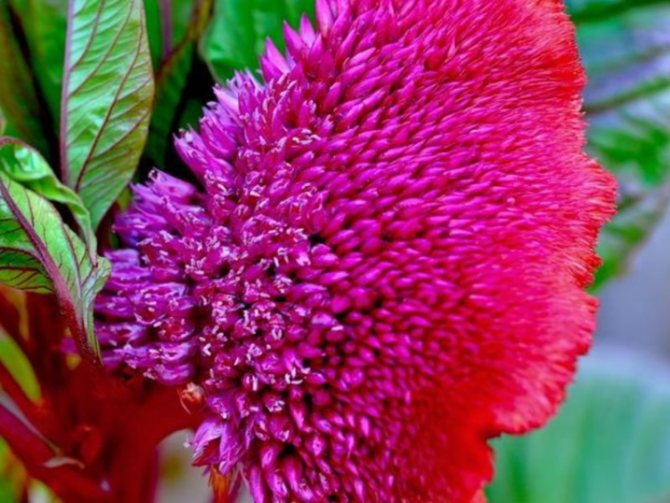

"Coral Garden"
This velvet variety can reach as much as 50 cm in height, therefore it is most often grown in a garden. The stems are straight, rather fleshy. Inflorescences are small, scallop-like, very bright.
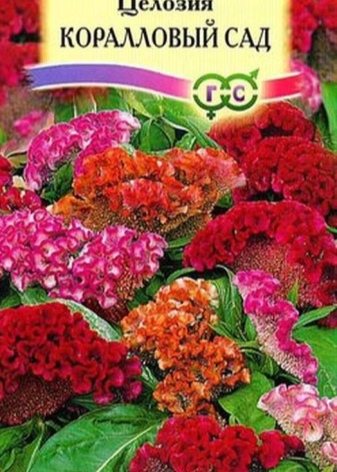

Description of the plant
Celosia is an annual or perennial herb or shrub 30-90 cm high. The upright ribbed stems branch slightly. They are covered with light green smooth or slightly rough bark. On the shoots, petiole leaves of an ovoid or oval shape are alternately located. They have a smooth, bright green surface and solid or wavy edges. Sometimes there are varieties with variegated leaves, on the surface of which you can see silvery or pink stains.
From July to cold weather, celosia pleases with bright lush flowering. On the tops of the stems and in the axils of the upper leaves, multi-flowered inflorescences of a comb, spikelet or feathery form bloom. They consist of small bisexual flowers, colored pink, yellow, orange, burgundy or scarlet. In an inflorescence 10-25 cm high, the flowers are very tightly pressed against each other, so the presence of pedicels and the shape of a single corolla is very difficult to distinguish. The calyx consists of 3 brightly colored bracts. In the center there are 5 stamens united by a membranous tube and an elongated ovary.
After pollination by insects, fruits ripen - polyspermous rounded capsules up to 4 mm in diameter. The upper part of the ripe capsule, like a lid, opens and oblong seeds up to 2 mm long pour out of it.
Reproduction
To get planting material, in the fall, you need to cut off several wilted inflorescences. They should be dried in a dark and cool place. After this is done, the inflorescences must be shaken over the paper, and the finished seeds are poured out of the plant in abundance. These seeds are put in tightly closed containers and placed in the refrigerator.
In early April, the seeds are ready for planting. But first they need to be processed. This will help tools such as "Zircon" and "Epin". In a glass of plain water, dissolve a drop of each of the preparations, and the inoculum is soaked for 4 hours. In addition, it will be useful to treat the land and seeds with a manganese solution - this will strengthen the plantings, make them less susceptible to diseases.
Several grooves are made in the soil (in a container), but you can simply loosen it and place the seeds.
A soil made of humus and vermiculite, with a small addition of clean sand, is suitable as a soil.
They do not fall asleep with soil from above, only slightly press down and spray from a spray bottle. Then they cover it with polyethylene, and place the container with the material in the warmest part of the apartment on a well-lit windowsill. Wherein the temperature in the apartment should not fall below +25 degrees Celsius... Periodically, the polyethylene should be opened so that the sprouts are ventilated.
Fertilizer
Planting and caring for sprouts and adult cellosis plants also include periodic feeding. If you follow a scientific approach, then complex fertilizers for flowers should be added to the soil once a month. But practical cultivation experience shows that it is better to divide one portion of fertilizers into several and apply to the soil weekly during watering (Figure 6).
Figure 6. Organic and mineral substances can be used as fertilizer
With such a feeding schedule, the plants will receive the required amount of nutrients, but at the same time their excess will not be observed in the soil, which also negatively affects the development of the culture.
Landing
We have already disassembled the planting at home, but often the plant is also planted in open ground.
Cockscombs are very fond of the sun, so they should be planted in well-lit areas where there will be no frequent drafts.
Celosia are planted in groups, the distance between low-growing bushes should be about 15 cm, between large ones - at least 35. The optimal time for planting is the end of May, when you will be sure that there will not be snow and frost. The correct air temperature is about +20 degrees Celsius.
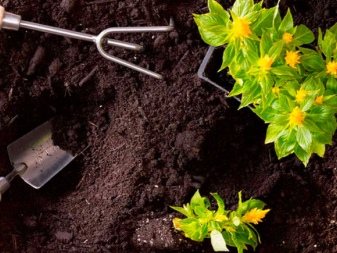

The soil should be light, fertile, slightly acidic. If the acidity is increased, liming is used. After the place is chosen, and everything is prepared, the planting begins. This is done by the transshipment method: the plant is removed from the pot along with an earthen clod and planted in the ground. This will help the culture take root well. In the case when the scallops were dived into the peat pots, it is allowed to plant flowers in the soil directly in them. After planting, the plants are watered.
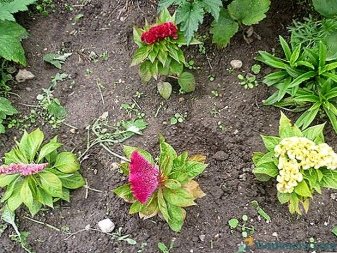

Methods for propagating flowers of celosia pinnate
In addition to growing seedlings from seeds, you can propagate feathery celosia by cuttings. To do this, you need to cut off the branches from the plant, on which there should be at least five sheets. They need to be placed in a container with boiled water, into which you can add a growth stimulant or aloe juice. In this case, roots form quickly on the cuttings, and after half a month they can be planted in the garden. Outdoors, plants obtained by cuttings do well, but usually flower less abundantly than those grown from seed.
Follow-up care
Care activities include several mandatory stages.
Watering
Both indoor and garden celosia do not tolerate waterlogging well. Therefore, such plants should be watered sparingly, only when the soil dries up. In the rainy season, you can generally do without watering before the onset of hot weather. After the supply of water, the garden celosia must loosen, and also uproot the weeds that have appeared.
The correct time for watering is the earliest morning, but if this is not possible, you can postpone the event to the evening. The water must first settle, and many gardeners use rainwater - this is the best option. The temperature of the liquid should be at room temperature, since cellosia does not tolerate cold water, even if it is hot outside, it may even die from this.
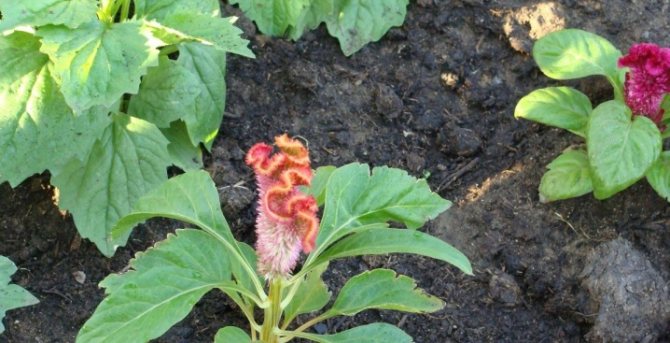

Fertilizers
Top dressing should be dosed. They begin to do this in the second month. For these purposes, phosphorus and potassium are used. Many gardeners also add nitrogen, but this must be done very carefully. If you overdo it, then the plant will quickly gain green mass, but it will not have enough strength for flowers.
Complex fertilizers should be applied monthly. However, experienced gardeners advise using a different tactic: divide the fertilizer into several parts, dilute in water and give with each watering. Thus, it is possible to ensure that the concentration of nutrients in the soil will be at the desired and stable level, excluding excess.
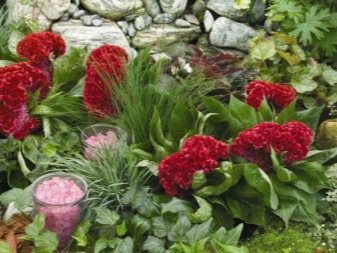

As for the shelter for the winter, then it is not carried out, because even with the best shelter, the plant will not survive.
The cockscombs are cut and left to dry in order to obtain seeds. Moreover, the plant is stored for a very long time in a dried form, so after collecting the seeds, you can put it in a vase and enjoy the delicate aroma.
Feathering care for pinnate
Celosia pinnate loves good lighting
Although the cultivation of feathery cellosia is not difficult, yet when breeding a plant, you need to know some of the intricacies of its content.
Location selection and lighting
Like most tropical plants, celosia pinnate loves good lighting. Therefore, for its location, you need to choose a solar site, protected from the wind.
Watering and feeding
Celosia pinnate requires regular, moderate watering. In this case, it is necessary to let the top layer dry well in order to prevent waterlogging of the soil, which leads to decay of the root system. It is also recommended to periodically loosen the soil to increase air permeability.
After planting pinnate cellosis in the open ground, feeding is carried out once a month with universal complex fertilizers. You should not do this more often, since an excess of nutrients in the soil leads to inhibition of flowering.
Important: Celosia does not tolerate fresh organic fertilizers, you can add a small amount of bone meal or compost to the soil.
The soil
Choose the right soil when planting cellosis
The soil for planting celosia pinnate should be chosen loose, well-drained with a slightly acidic reaction. The following composition can be considered the best option:
- deciduous land - three parts;
- loam - two parts;
- rotted manure - one part;
- coarse sand - one part.
A small amount of crushed charcoal can be added to the prepared mixture.
Celosia pinnate after flowering
After flowering celosia pinnate retains its decorative qualities for some time, thanks to its foliage, not only green, but also golden or purple. Since the plant is an annual, then with the onset of the first frost, it dies.
When to Harvest Celosi Seeds
At the end of flowering, fruit-boxes are formed on the pinnate celosia, in which there are round black seeds. In those regions where they have time to ripen, they can be harvested at the end of autumn and stored for five years, during which they retain a high percentage of germination.
Disease and pest control
In general, cetacean crested quite well resists all sorts of ailments, the exceptions are only very young plants that have not yet received proper immunity.
One of the main diseases of the culture is the black leg. It appears as a result of excessive moisture in the soil or air, as well as if the plants are too densely planted. The base of the stem turns black, the fungus clogs it, preventing sap flow. As a result, the culture turns yellow, dries up and dies. The gardener needs to remember that the black leg will easily infect other flowers, so it will not be possible to restore the stem from a dying plant. It must be dug up and then destroyed. The land at the site of the dug out flower is treated with wood ash, other plants need to be temporarily not watered. Preventive measures to protect against blackleg are that the seeds are disinfected with manganese even before planting, and the soil is also spilled with it.
Another ailment is deciduous chlorosis, which arises from a lack of iron. With this disease, the leaves of the culture turn yellow, only the streaks will be bright. Solving the problem is quite easy: you just need to feed the culture with iron and revise the rules for its cultivation.
Of the pests, celosia is most often affected by aphids. It appears where there are a lot of ants, so you need to deal with them in a complex. Semolina scattered around the plants helps well against ants, and you can also destroy anthills by hand. At first, aphids are perfectly washed off with soapy water, but if time is lost and there are too many insects, only strong insecticides will help.
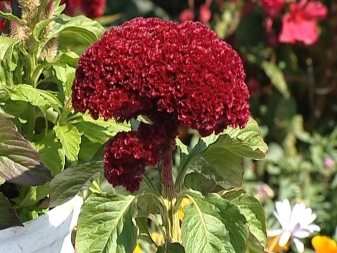

In addition to aphids, plants can also eat up insects such as bears. These creatures are omnivorous, but most of all they like to damage the roots, from which they suck out all life juices, causing wilting and death of the plant. Bears live underground, only occasionally getting out to the surface. You can destroy them with insecticides, which are best poured into the ground with water. And also many gardeners knead sweet corn sticks and add poison there. After that, the gruel is buried in the ground, and after a few hours the pests crawl out to the surface due to lack of air. In addition, marigolds can always be planted along the edges of the flower beds - this will serve as a good preventive measure.
Reproduction and seedling of cellosis
Growing celosia flowers from seeds is practically the only way to reproduce this plant in our climatic environment. In a natural climate, celosia is a perennial, but in our country it grows as an annual plant. Note that cellosia can propagate by cuttings, but in this case it will lose its decorative appearance.
The seeds of these flowers can be bought, and after the first flowering season you will harvest your harvest - there are more than 500 seeds in the inflorescence. They are stored for a long time and do not lose germination for 2-3 years.
Celosia paniculata (cristata)
Not all gardeners know that the seeds of this flower are covered with a hard shell. If it is not softened, the seeds will not crack and the plant will not sprout. It is recommended to soak the seeds 5-6 hours before planting in a solution of Epin or Zircon. 1 drop of any drug is added to 1 glass of water, seeds are dropped there.
The dense shell softens and the seeds must be immediately submerged in the ground. Note that the landing is carried out in late March - early April, when the first warm sun rays are already warming the earth.
How to sow plant seeds into the ground?
Sowing seeds is done in the soil, which consists of equal parts of humus, vermiculite, you can add sand.If there is no such soil mixture, then simple garden soil will do, but it should be very loose and not contaminated with fertilizers after old crops. Seedlings are planted in a box in well-fluffed ground. The seeds are laid out on the surface of the soil, after which they are lightly sprinkled with earth.
It is recommended not even to sprinkle the seeds, but just spread them loosely on the surface of the soil, sprinkle with water from a spray bottle and cover with a transparent bag. A box or bowls with seedlings are placed on a well-lit windowsill, do not forget about airing. You need to remove the film once a day for 1.5 hours. Without airing, the plant will suffer from black leg disease.
Examples in landscape design
Celosia comb is a frequent guest of many gardeners. She looks great on any site, interestingly complementing it with her bright and rich color.
Most often, cockscombs are planted in groups in flower beds. At the same time, they can be combined with flowers of various shades, but white looks the most impressive.
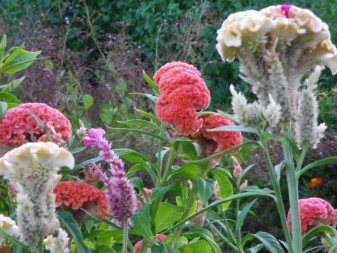

Scallops with marigolds also look original: these flowers are not only beautiful, but also useful, they help against many pests. Moreover, celosia can be completely diluted with nothing: in a large flower bed, she will feel great alone. The main thing is to choose several shades, at least two.
Comb cellosis
Comb celosia - this type is most often found in personal plots, and it is very popular with flower growers. This type of celosia looks great on absolutely any personal plot, the flowers have a bright and decorative color. In general, cellosis are best planted in groups, since the inflorescences in the form of cock's combs look even more attractive and decorative. At the same time, they also perfectly combine with other flower crops of a wide variety of colors and colors, but white celosia looks most impressive. Scallops also just look great and spectacular in combination with marigolds, since these flowers have not only spectacular decorative features, but they are also very useful, since marigolds can scare off many insects and pests. In addition, celosia can generally not be diluted with anything else, it will feel great even in a single planting. The main thing is to choose at least a few shades so that the flowerbed looks solemn and attractive.
Also, celosia can be planted along the paths, for this you can choose the brightest and most spectacular colors. Flowers can be used to frame paths, walls of houses. In addition, in contrast, these plants look incredibly impressive and attractive. Indoor plants also look attractive and interesting. For example, if the choice of a florist fell on undersized plantings, then the gardener will only benefit from this, since the plantings will stand out, will look like bright spots. Celosia can decorate balconies, terraces, window sills. Reviews about this plant are mainly only the most positive, since it is really capable of decorating various territories and rooms with itself. The main thing is to comply with all caring measures that are just prescribed in the framework of agricultural technology.
Testimonials
Considering the reviews about crested crested, we can conclude that a lot of people liked such a plant. There will be no costs for seeds at all, since every year in the fall, the gardener has the opportunity to collect seed and plant it. In addition, problems with cultivation usually do not arise, since the plant is not too demanding on the soil, the only point here is the need for proper watering.
But most of all summer residents like how beautiful and original culture looks... Interesting in itself, it also goes well with other colors, causing a real extravaganza of colors. Looks great on a flower bed, flower garden, alpine slide, at home, in a park or square.
There are also negative aspects. For example, some summer residents do not like the fact that the plant has such a low frost resistance, and it has to be planted again every year. However, there is nothing you can do about it. And also newcomers argue that the culture easily gets sick with fungal ailments, which contributes not only to its rapid death, but also to the rapid infection of other plants on the site. But here, too, there is a solution: take into account all the rules of growing and strictly follow them.
In this way, crested celosia is a spectacular and very funny plant, which will not be difficult to grow... An interesting and unusual type of culture can easily replace many more expensive and capricious flowers, and the opportunity to admire the inflorescences after flowering will undoubtedly delight any gardener.
See the video about growing cellosis from seeds and caring for it.
Celosia is an unpretentious flower from the Amaranth family, a perennial plant grown as an annual. Silver celosia is the best decoration for the flower beds and the bed of your garden. Celosia is also grown in pots and flowerpots at home.
The homeland of silver celosia is hot Africa, Asia and South America. More than 60 types of celosia are known, however, in gardens, greenhouses and indoor gardens, silver crested celosia and spikelet celosia (Hatton's celosia) are most often grown.
Hundreds of varieties of celosia, bred by breeders around the world, will not let you get bored of the monotony. In this article, I will give examples of just a few varieties of cellosi that are most often sold in stores. You can try exotic varieties of cellosi on your own if you enjoy growing it.
By the way, the people do not know the scientific name of silver celosia - they simply say: cock's comb or cockerel. A rare gardener asks for cellosis in a store, and the sellers know that a cockerel or a scallop is cellosia. Therefore, it is enough to remember for yourself the "flower cockerel" and the trick is in the bag - you can go for the seeds.
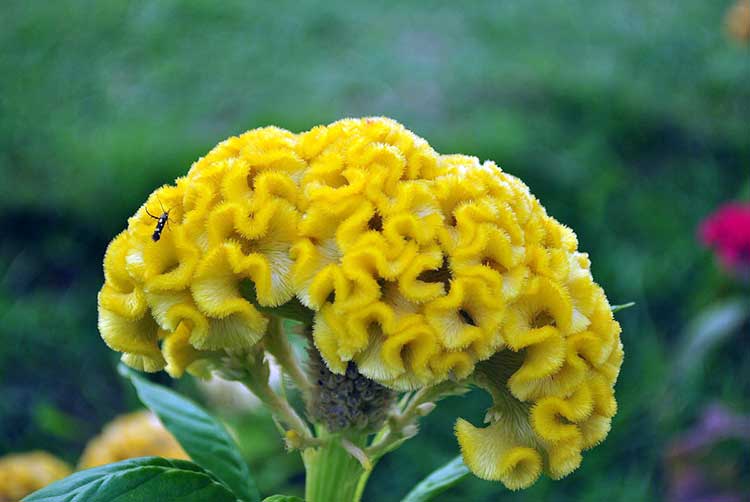

Yellow inflorescences of celosia look spectacular in any environment. Pictured is Celosia cristata. Source: Wikipedia
Scallops bloom from early July until the first frost and abundantly set seeds, but the seeds do not fully ripen.
Temperature and watering
Celosia, although an unpretentious culture, still needs some care after sowing and planting in the ground. Keep in mind that the plant absolutely does not combine with high soil moisture and reacts poorly to drafts, therefore, both the planting site and the irrigation schedule should be selected very carefully.
Figure 5. Watering the flower should be regular, but not too abundant
Watering the culture should be moderate, since cellosia does not tolerate waterlogging of the soil well, but it also does not actively develop when it dries out. Ideally, moisture is applied daily in the morning, but in too hot weather, it is better to postpone the procedure to the evening. However, if there is natural precipitation, watering can be temporarily stopped.
Irrigation water is also needed not quite ordinary. Firstly, it should not be hard, so it is advisable to let it settle, or use the collected rainwater. Secondly, the liquid should not be cold. Use only water at ambient temperature. Otherwise, the root system of plants will experience a strong shock and the flower will die, even if it has enough heat and light (Figure 5).
Cellosis facts
- Since ancient times, silver celosia has been used as a food plant in Indonesia, India, Nigeria, and Central America. Celosia has edible young leaves and plant shoots.
- From the seeds of scallops, celosic oil is extracted.
- In folk medicine, celosia is used to expel worms, to treat blood diseases, mouth ulcers, and vision problems.
- Silver celosia (lat.Celosia argentea), is actively grown as a garden ornamental plant (usually as an annual used to organize curbs), as a cut plant, and also as a pot plant.
- Celosia silvery was introduced into the culture during the Renaissance, so it has long become a common plant for European gardens.
- The varieties of silver celosia are divided into two groups: the Plumosa group includes varieties with inflorescences in the form of a plume of small deformed flowers of various colors (plants of this group are grown for cutting); to the Cristata group - varieties with inflorescences in the form of wavy ridges from accreted shoots.
Photo gallery
Growing celosia in the garden
Due to their African origin, scallop flowers are unpretentious and resistant to irregular care.
To enjoy the flowering of celosia as early as possible, the cockerel is grown in seedlings. In March-April, seeds of celosia are sown in separate cups, covered with foil or glass and placed in a bright place, protecting them from the scorching sun. The germination temperature of cellosia seeds is + 17–20 ° C. Cockerel seeds germinate within 7 days. Choose the size of the cups so as not to dive the seedlings of the celusion - they do not tolerate the dive well.
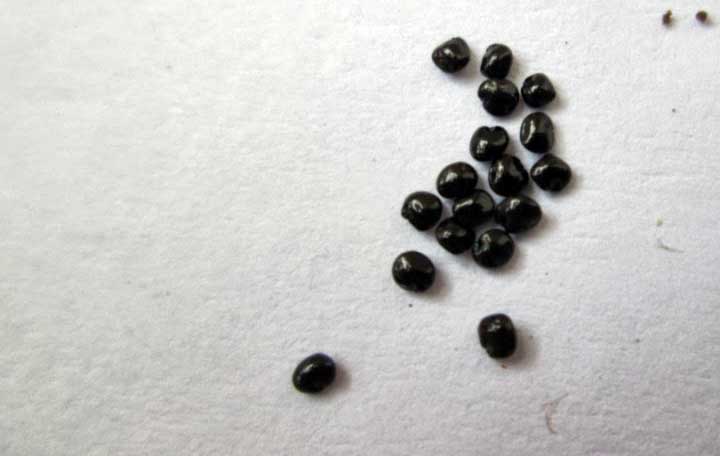

Celosia seeds are just over 1 mm in size. Photo: Design Green India
The seedlings of the cellosis are watered carefully so that the soil does not dry out. Pouring over young plants is harmful. Celosia is planted in open ground when the threat of spring frosts disappears - the plant loves warmth, remember about African origin.
When and how to plant cellosia in open ground
Celosia pinnate is a very thermophilic plant, for which even a short-term stay at low air temperatures is destructive. In this regard, planting seedlings in open ground should be carried out only when the spring night frosts end, and the soil warms up enough. This is usually done at the end of May.
Important: if for some reason you have to plant feathery celosia earlier, then you need to take care of equipping a shelter for it.
Before starting planting, you need to prepare the site well. This must be done a month before disembarkation, and best of all in the fall. The soil must be covered with humus, dug up and disassembled. Seedling holes are made at a distance of ten to thirty centimeters from each other, depending on the expected size of adult plants. After planting the seedlings, you need to water them, and then mulch the soil around them with sawdust or peat.
Celosia in garden landscaping
Scallops are just a gift for landscape designers - wherever they are planted, they will decorate the garden. Cockerels look good on flower beds and beds in mixed plantings.
Low-growing varieties of celosi can be used to decorate balconies. In this case, designers will appreciate the colorfulness of the bright inflorescences and the decorativeness of the celosia leaves. In addition, celosia looks great in flowerpots and containers.
Even in winter, you can admire the blooming whole - it is enough to make a dry bouquet out of the cockerel. Dried celosia does not lose the brightness of the inflorescences and retains its fresh appearance for a long time. To make a dry bouquet of celosia, you need to dry the cut plants by hanging them down with their inflorescences.
2.Cultivation
2.1 Celosia - planting and care in the open field
Celosia is planted in open ground using a previously obtained or purchased seedlings... It is also possible sowing seeds directly into the ground, however, celosia will have time to form inflorescences only in the southern regions, in the middle zone of flowering it may not occur.
Pre-seedlings temperplacing containers with young flowers in the fresh air during 2 - 3 hours in the afternoon. Gradually, the time is increased and before planting the plants can be left outside and at night.
Depending on the climate in a particular region, the planting dates will be different - in the Middle Lane, plants are planted outside in the second half of May - when the threat of return frosts has passed.
↑ Upward,
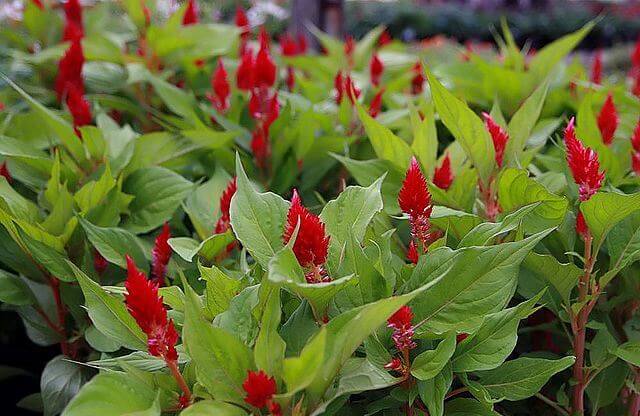

For planting, a location is selected that will satisfy the plant's need for good lighting.
The landing site should not have close groundwater and should not be located in a lowland; it is also worth choosing a place protected from strong gusts of wind.
Since celosia prefers soils with neutral pH, then before planting it, it is necessary to deacidify the earth with the help of lime milk or adding simple crushed chalk, dolomite flour or ash left over from burning wood to the soil.
Nutrient-poor soils additionally enrich mineral fertilizers for flowering plants, and coarse-grained is added to too heavy and dense soil river sand and wood ash to loosen and improve drainage.
↑ Upward,
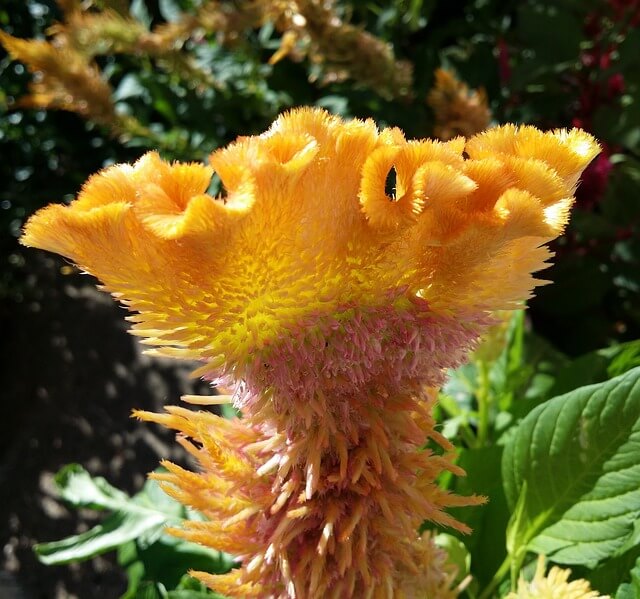

The site for planting is pre-dug up and weeds are removed.
The planting pattern will depend on the particular plant variety and growing method - cellosia can be grown as a single plant or in group plantings.
Planting holes are prepared, between which they are kept distance from 15 to 30 cm... Nutrient can be placed at the bottom of the planting holes. organic layer in the form of well-rotted horse or cow dung. Celosia does not like the use of fresh organic dressings and may even die from their use.
Young bushes are transferred to the planting holes neatly, by transshipment, trying not to destroy the old clod of earth.
Flowers are placed in the center of the hole and sprinkled with earth around the perimeter, which is then lightly tamped to remove air pockets.
Transplanted plants only watered abundantly and regularly, over time, the flowers will endure a short drought.
↑ Upward,
Further care for the planted plants will consist in timely watering and feeding, as well as in weeding and loosening the soil.
For the onset of a bright and abundant flowering, mineral fertilizers for flowering plants monthly.
Since celosia refers to annual plants, on fine autumn days, flower stalks can be cut from the bushes, dried and used as dried flowersthat can decorate any interior and will retain an attractive appearance until spring.
Drying is carried out in a place inaccessible to direct sunlight with a warm and dry atmosphere. The drying room must be intensively ventilated.
↑ Upward,
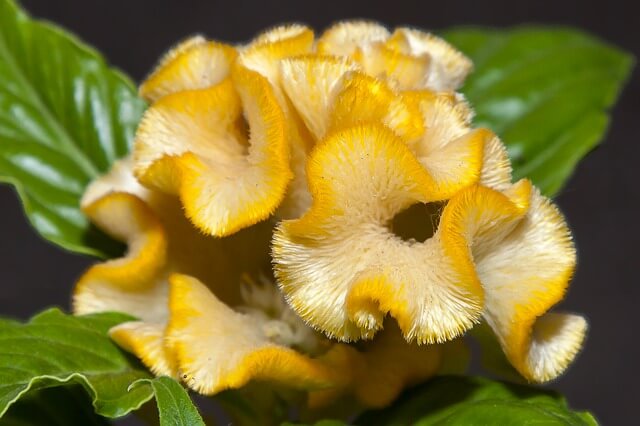

Perennial varieties in the autumn months, when the temperature at night drops to 5 ° C, dig up and carry over in pots that place in the House.
↑ Upward,
2.2. Reproduction, growing from seeds
Seeds are planted into the ground in the spring - in the second half of March or April. For sowing, you can use seeds of your own collection.
They try to collect them in dry and warm weather. Withering inflorescences are removed from the plants and hung upside down. A white sheet of paper or white cloth is placed under the inflorescences.
As it dries, the seeds will spill out onto the leaf themselves.
↑ Upward,
Since the seeds have a too hard outer shell, the planting material will need pre-sowing treatment for successful germination.
↑ Upward,
- The seeds are soaked for 3-4 hours in warm water with the addition of drugs such as epin and zircon. If you sow dry seeds, then the germination rate will be low and they will germinate only after 2 - 3 weeks.
- After soaking, cool stratification can be carried out in the vegetable compartment of the refrigerator - the seeds are placed like this for 3 to 4 hours.
- Sowing is carried out in a container with a moist, nutritious and loose organic-based substrate - for example, in a mixture of humus with coarse-grained river sand or vermiculite.
- Since the seeds need light for germination, the crops from above are not covered with earth, but simply slightly pressed the planting material into the surface of the soil.
- You can sow seeds immediately in separate cups - in this case, you can avoid diving of young plants.
- The substrate is kept moist using a fine spray gun, moistened with water at room temperature or slightly higher.
- The top of the container is covered with clear plastic, glass or plastic wrap to maintain high humidity levels and create a greenhouse effect.
- Every day, the shelter is removed and the seedlings are aired, and the condensate that has appeared is also removed from it.
↑ Upward,
The seedlings are kept in a warm place at a temperature 23 - 25 degrees Celsius... At lower temperatures, some of the seeds will not germinate.
The location should be brightly lit but out of direct sunlight.
During 7 - 10 days the first shoots may appear - the shelter is being removed at this time.
With the emergence of seedlings, they organize a daily artificial lighting in the form of fluorescent or phytolamps. In insufficient light, the sprouts will be elongated and ugly.
Since cellosia will develop better with a long daylight hours, then it is increased to 14 - 16 hours.
↑ Upward,
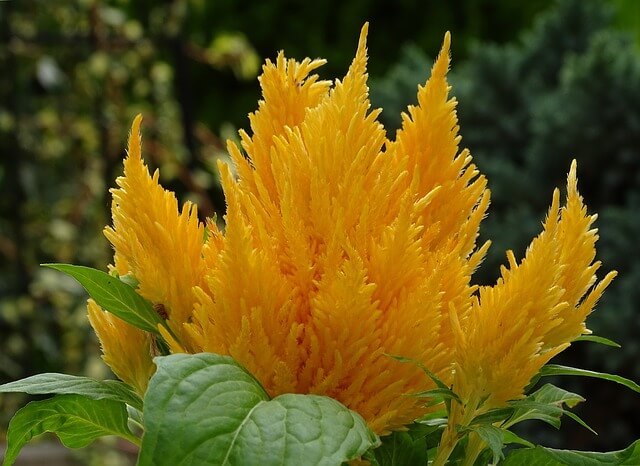

Dive do when each small bush becomes the owner of 2 - 3 real leaves - the bushes are carefully transferred into small cups, trying to disturb the root system as little as possible.
The first top dressing young plants are carried out 7-10 days after diving, using a very weak solution of mineral fertilizers with a high nitrogen content.
Second dive carried out, if necessary, with the appearance of already 5 - 6 true leaves, increasing the volume of the pots in which the plants are grown.
5 - 7 days after the second dive, the plants begin temper - gradually reduce the temperature of the content to 17 - 20 ° C.
↑ Up,
Vegetative propagation is also possible or graftingbut plants obtained from cuttings often do not retain their attractive appearance.
↑ Upward,
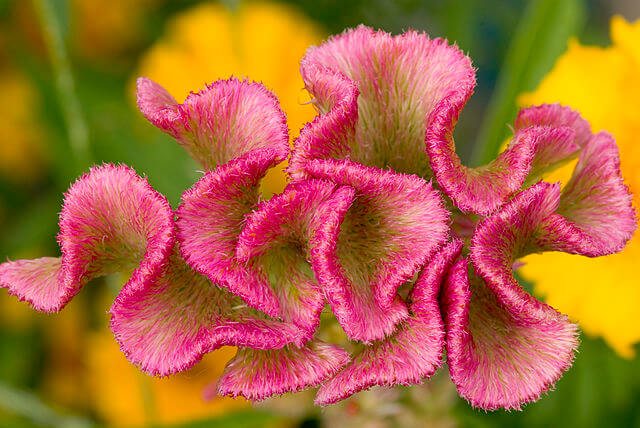

2.3 Soil
The plant tolerates nutrient-poor soils, but prefers well-drained, high organic matter, preferably with neutral or slightly acidic pH ranging from 6 to 6.5.
A growing mixture can be made on the basis of foliage and sod land, humus with the addition of coarse river sand, perlite and vermiculite to improve drainage.
A small amount of charcoal can be added to the soil as additional nutrition and to loosen it.
The substrate should not only allow moisture to pass through easily, but also allow the root system to breathe.
↑ Up,
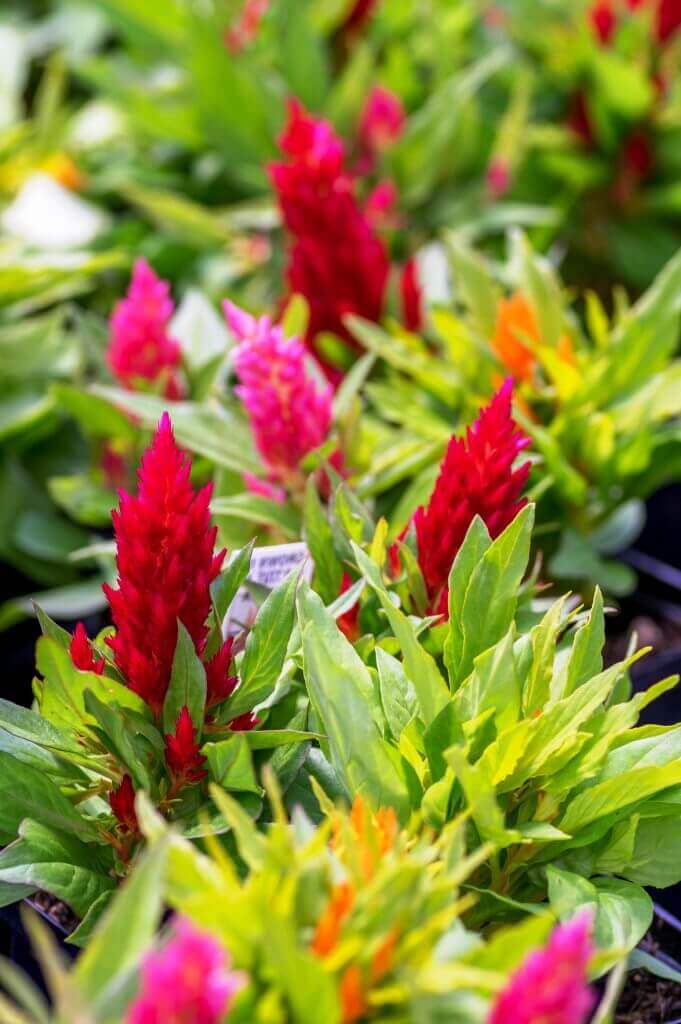

2.4 How to grow cellosis in your home
The plant is extremely unpretentious, but requires compliance with certain agricultural techniques.
Tips of young shoots pinch for better branching and subsequent abundant flowering.
Take out indoor plants outside in the warm season, placing them there under cover from strong gusts of wind, rain and direct sunlight.
Stems of tall species may need to be support for growth and development.
↑ Upward,
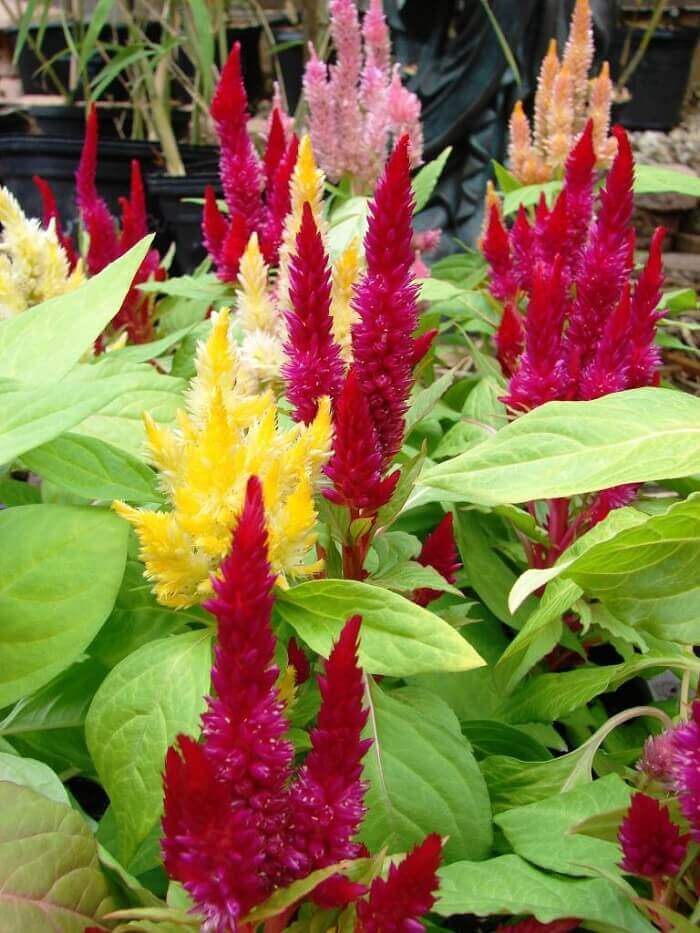

2.5 when celosia blooms
Mid-summer to mid-autumn, flowering continues until 2 months... When grown in open ground, only the onset of frost is capable of interrupting the flowering of cellosia.
↑ Up,
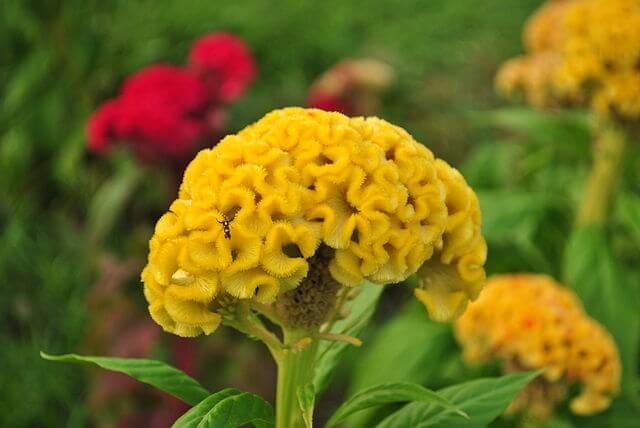

You may also be interested in:
- Cineraria - photo, planting and care in the open field, growing seedlings, keeping as a houseplant and in a flower bed, flowering time at home, description of the plant
- Amaranth - photo of a plant, useful properties, growing a flower from seeds, planting in open ground, family, soil for sowing amaranth
- Alyssum - photo of a flower, planting and care in the open field, growing from seeds, keeping a plant in a pots - soil, fertilizer, lighting
- Lobelia - flower photo, planting and care, growing seedlings, keeping in open ground, in a flower bed, on a balcony and in a pot, flowering time of a house plant, transplanting
↑ Upward,
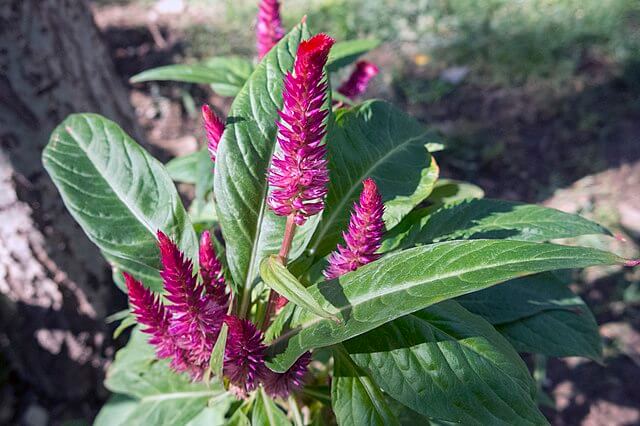

2.6 Diseases and pests
- Flowers are susceptible to root rotespecially in poorly drained soils.
- With insufficient moisture leaves cellosi lose turgor and descend, and the plant ceases to form new flowers.
- With an excess of nitrogen in the substrate, the plant is abundantly build up green mass to the detriment of flowering.
- Blackleg appears with insufficient air movement and strong waterlogging of the soil - young plants are often susceptible to this disease.
- Chlorosis appears in plants with a shortage of such a nutrient as iron - the leaf blades become light, almost yellow, and the leaf veins remain green.
↑ Upward,
Of the harmful insects the appearance of aphids is possible.
Insects are pests
| Insect name | Signs of infection | Control measures |
| Aphid | Sticky droplets appear on the leaf plates, the leaf plates curl and deform, delicate buds and young leaves wither. Colonies of insects can be seen on the tops of the shoots, on the buds or on the underside of the leaf plates. The flowers of aphid-infested plants may become deformed. | Folk ways: infusion of nettle, decoction of rhubarb leaves, wormwood, soap solution, infusion of tobacco and dandelion, onions, marigolds, yarrow, tansy, dusting with ash. Chemicals: Sulfur powders, treatment with green potash soap of green mass without getting into the ground, Decis, Aktellik, Fitoverm. |
↑ Upward,
2.7 Transplant
Plants belonging to annuals do not need to be transplanted - as they grow, they simply increase the size of the pots for seedlings.
Dive young shoots are carried out only by transshipment, keeping the root ball intact. Seedlings transplanted in this way receive less damage to the root system and start growing faster.
Perennial varieties are transplanted into new pots and fresh substrate in the spring when they appear first signs new growth.
The need for the next transplant will be indicated by the tips of the roots that have appeared in the drainage holes of the pots.
↑ Upward,
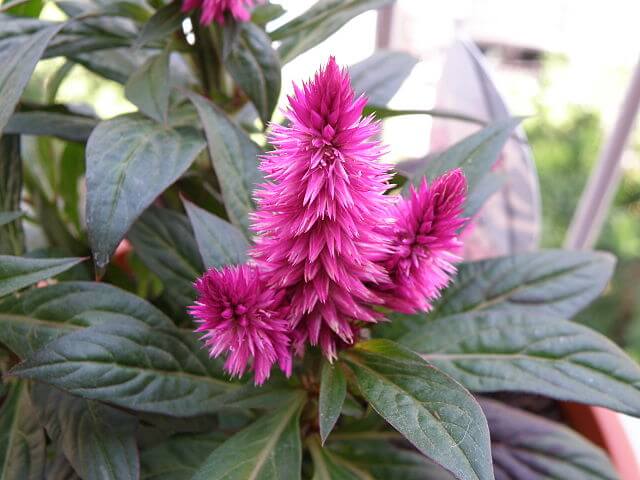

- For growing celosia, pots with large drainage holes are selected.
- At the bottom of the pots, a drainage layer in the form of expanded clay, river pebbles or fragments of clay pots must be laid.
- The flowers are carefully removed from the old pot and simply placed in a new container along with the root ball.
- Fresh soil is added around the perimeter, which is tamped with fingertips after planting.
- After planting, the bushes are watered abundantly with warm water and, if necessary, after watering, add a small amount of the substrate.
Frequent transfers and damage to the root system plants don't like and may even die.
Overloaded plants should not be exposed to direct sunlight.
The feeding of such specimens is suspended for a couple of weeks, since there are already enough nutrients in the new substrate, and the root system disturbed during transplantation may get burned from applying fertilizer too early.
↑ Upward,
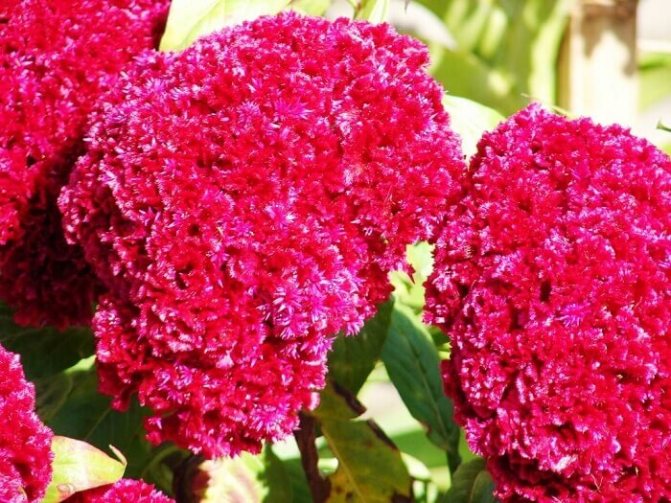

2.8 Containment Procedures - Temperature
The ideal temperature for cellosis at room temperature is from 16 to 22 ° C, these plants do not tolerate frost and do not like extreme heat - it can shorten the flowering period.
The onset of coolness - when the night temperature drops to 5 ° C, the plant stops forming flower stalks and dies.
↑ Upward,
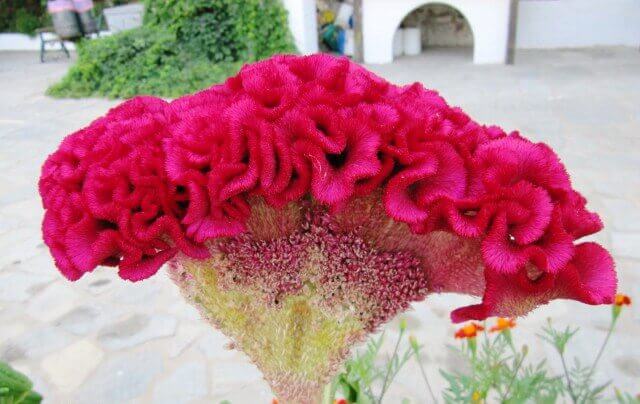

2.9. Top dressing
Celosia is fed twice a month fertilizers with a high content nitrogen in the first half of the growing season. For abundant bud formation, top dressing with a high content of potassium and phosphorus.
Mineral fertilizers can be diluted with water up to half of the dose recommended on the package. Top dressing is applied only to wet soil, after abundant watering, since the ingress of a too concentrated solution on the root system in a dry substrate can cause a chemical burn.
↑ Upward,
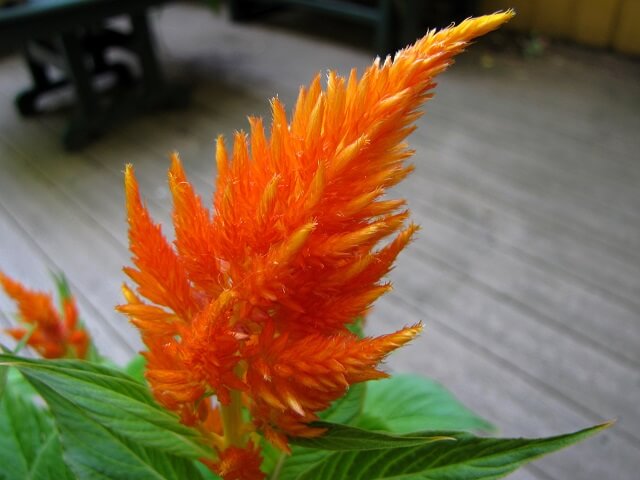

Celosia does not like organic fertilizers with fresh organic matter - they contain too much nitrogen, so they should not be used.Plants respond well only to well-rotted manure.
Freshly transplanted or diseased bushes should not be fed.
↑ Upward,
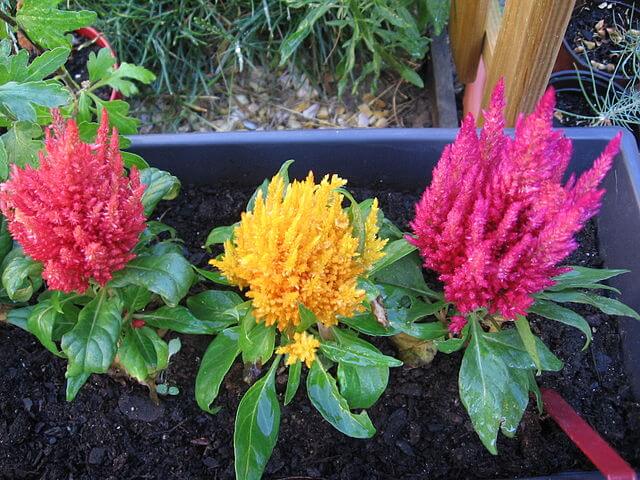

2.10 Lighting
Celosia loves a lot of bright sunlight in the morning and in the evening, some shade is needed in the afternoon.
Good lighting is critical for abundant flowering.
Most suitable for placement are windows eastern, southern or southwest orientation where the plants will bathe in the sunlight daily.
In low light, the plants will become loose and elongated. With a lack of natural light, you can successfully apply supplementary lighting fluorescent or phytolamps.
↑ Upward,
2.11 Watering
Growing as house flowers, these plants love regular watering during the period of growth and flowering.
Watering should be abundant - until the earthen coma is completely soaked.
Excess moisture that appears in the pan after watering must be drained a few minutes after it appears.
Keep the soil always moist during the growing season - spring and summer, but remember that too much water will cause rotting. During the period of active growth and budding, dry the surface of the substrate between waterings to a depth 2 - 3 cm.
↑ Upward,
For watering, use only well-settled room temperature water... You can also water the plants with melt water or rainwater collected far from city roofs.
When watering, droplets of moisture should not fall on the flowers, as this can reduce their decorative effect and lead to the appearance of ugly brownish spots.
Water from a watering can with narrow spouts, applying moisture to the edge of the pot. Can be applied bottom irrigationby immersing the flower pot in a large container of warm water for a few minutes and allowing excess moisture to drain through the pot's drain holes.
↑ Upward,
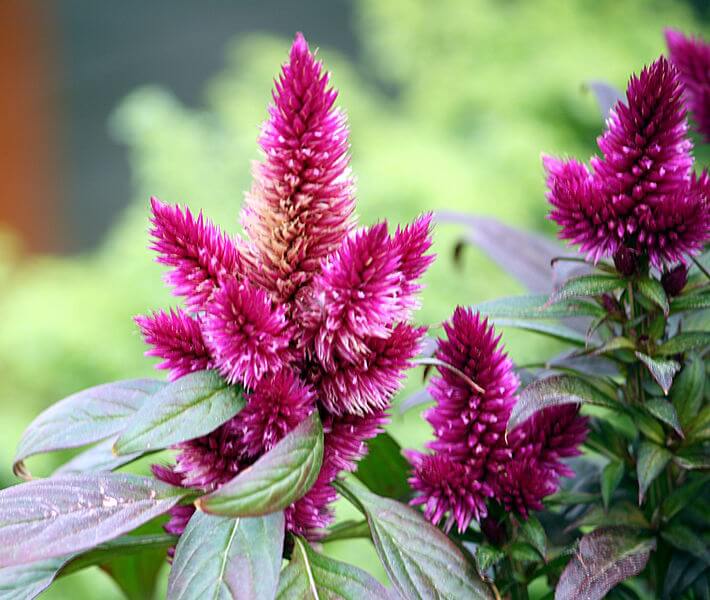

You may also be interested in:
- Ageratum - planting and care in the open field, growing from seeds, description, flowering, home care, in a pot, pinching, soil composition, sowing time
- Verbena - a photo of a flower, planting and care in the open field, growing seedlings, a plant in a flower bed, medicinal properties, description, content in a pot and in a pots, height
- Snapdragon - photo of a flower, growing seedlings from seeds, care in the open field and at home, planting a plant in a flower bed, height, pinching an annual
- Sanvitalia - photo, planting and care in the open field, growing from seeds, soil for a flower in a pots, plant description, propagation by cuttings, keeping at home, watering, feeding, transplanting
↑ Upward,
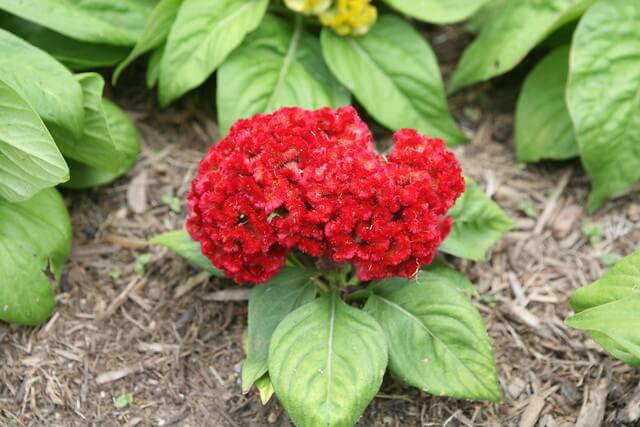

2.12 Spraying
Normal indoor humidity is well tolerated by cellosis if the soil is kept evenly moist.
Plants do not spray - to increase the humidity of the air, you can simply place any vessel with water next to the flower or place several plants in a limited space.
The plant should not be placed next to heating systems during the winter months or expose cold drafts... Take flower pots to another room if ventilated in winter.
↑ Upward,
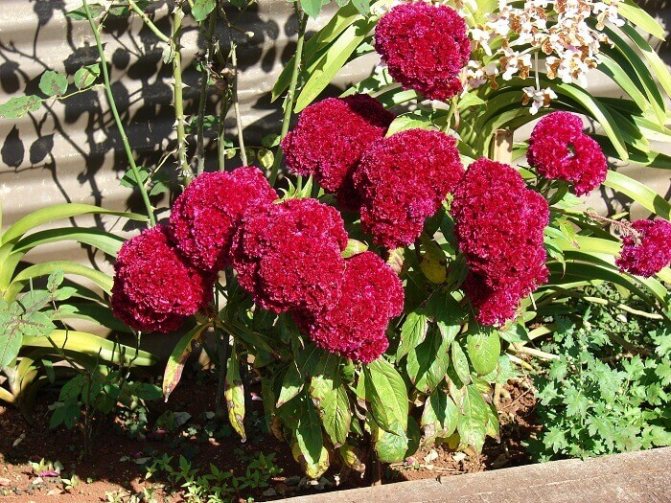

2.13 Intended use
Excellent flowers for cutting fresh, as well as dried flowers.
Several plants planted in one pot look extremely attractive.
Celosia rightfully retains its popularity among flower growers - its spectacular appearance and a variety of colors and varieties allow it to be widely used in landscape design.
↑ Upward,
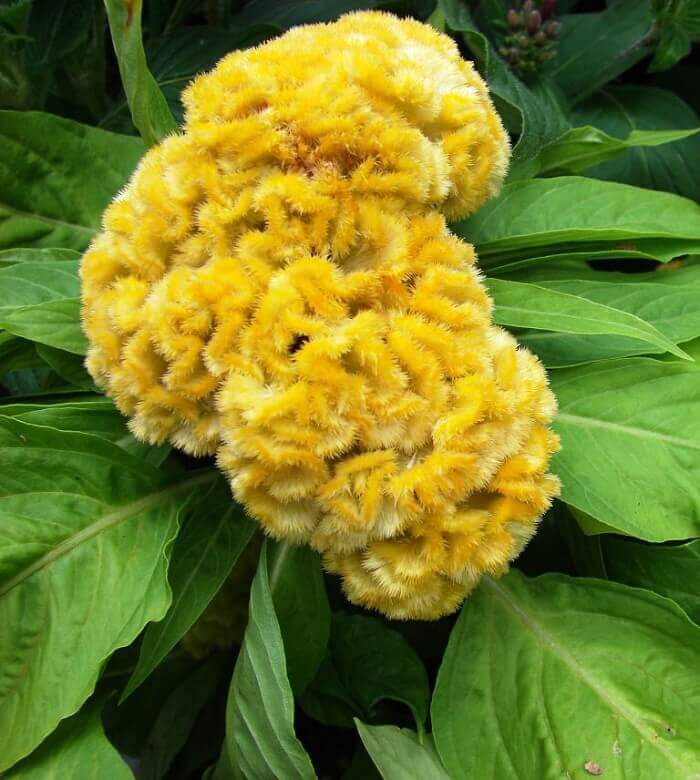

Note.
Hydroponics.
Types and varieties of cellosia
Celosia is silvery comb. Silver crested celosia (lat. Celosia argentea f. Cristata) is a beautiful perennial plant, reaching a height of 65 cm, mainly grown as an annual.
Small bright flowers of crested comb are gracefully collected in massive inflorescences with a row of convolutions along the upper edge.Due to the fact that the shape of the inflorescence is similar to the comb of a rooster, the plant is called that - a rooster's comb.
The flowers of celosia with a comb are amazing not so much in an unusual shape as in an incredibly diverse color: they can be yellow, scarlet, purple-red, orange, bright pink. None of the plants can boast of such an unusual bright outfit, therefore a flowerbed with a comb-like plant always attracts admiring glances of passers-by.
Flower growers appreciate Celosia comb both for its exotic bright appearance and for its long flowering, which lasts from early July until October. And even after its completion, it does not lose its decorative effect: the leaves shine (depending on the variety) with a bright green, red, burgundy, purple, bronze and even golden color.
Celosia "Impress" grade. In the middle lane, the most common cultivated varieties are "Impress". The flowers of the variety are distinguished by a bright burgundy inflorescence and dark purple leaves.
Celosia "Imperialis" grade. Stunted, reaching only 25 cm in height. The plants of this variety have bright purple leaves, which seem to be divided into parts by thin red veins, and beautiful burgundy shoots with purple inflorescences.
Celosia grade "Atropurpurea". Another popular variety of comb celosia is Atropurpurea. The plants are distinguished by very large purple-red inflorescences, a pale pink stem and unusually beautiful light green leaves with dark pink veins.
Celosia is silvery pinnate. Silver feathery celosia (lat.Celosia argentea f. Plumosa) is the second popular species. Annual. Lush bloom lasts for several months - until the first frost. Various varieties of celosia pinnate form a small bush with many bright paniculate inflorescences, the length of which is usually equal to a third of the total plant height.
Among the many varieties of cellosia pinnate are:
- tall - reaching up to 1 m in height;
- medium-sized - whose height fluctuates within 0.5 m;
- dwarf - their height does not exceed 30 cm.
Celosia pinnate "Golden Flitz" grade. One of the most popular varieties of cellosis pinnate. Reaches 80 cm in height. Inflorescences are golden-orange.
Feuerfeder pinnate cellosia. The variety "Feuerfeder" is also popular - the plant reaches a height of 35 cm. Inflorescences are bright red; leaves are light green, with pink veins.
Celosia is spiky. The least popular among gardeners is the spike-shaped celosia, the inflorescences of which resemble wheat.
Bright, slender inflorescences can reach a height of 1.3 m and vary in color: from pale yellow to bright red.
What does cellosis look like and when does it bloom?
The homeland of this plant is India, Asia, Africa, South America, the cichlid fish is also found there. The plant is good where it is warm and there is a lot of humid air.
Expert opinion
Ivan Kuznetsov
Farmer
I would like to recommend you homemade oyster mushroom mycelium - the first harvest in 10 days, it grows at any time of the year for free - want to try it?
To learn more
Exotic inflorescences of celosia look very elegant, and they are planted in groups, resulting in a velvet multicolored field. The inflorescences of the plant are collected so tightly that they form a relief pattern, most often similar to the comb of a rooster.
There are more than 60 types of beauty celosia, and almost all of them take root well in our climate.
By the type of structure of the petal, they are divided into 3 groups:
- Comb-shaped.
- Spikelets.
- Cirrus (plume).
And the flowers are red, crimson, dark pink, orange and yellow. Celosia looks like haute couture, so refined and unusual it is.
Harmful effects on the plant
Seedlings from excess moisture can be struck by a black leg. If you notice a black color on the stem at the roots (signs of this disease), fluff the soil near the stem and sprinkle it lightly with wood ash and forget about watering for a while.
If aphids appear on the plant, prepare such a solution: mix 2 tsp. liquid soap with a glass of vegetable oil and two glasses of water. Spray the cellosis with this solution. Repeat several times at short intervals in the evening.
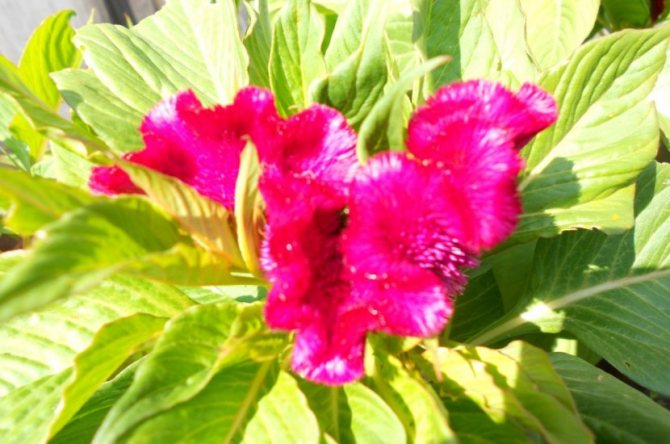

Celosia landing
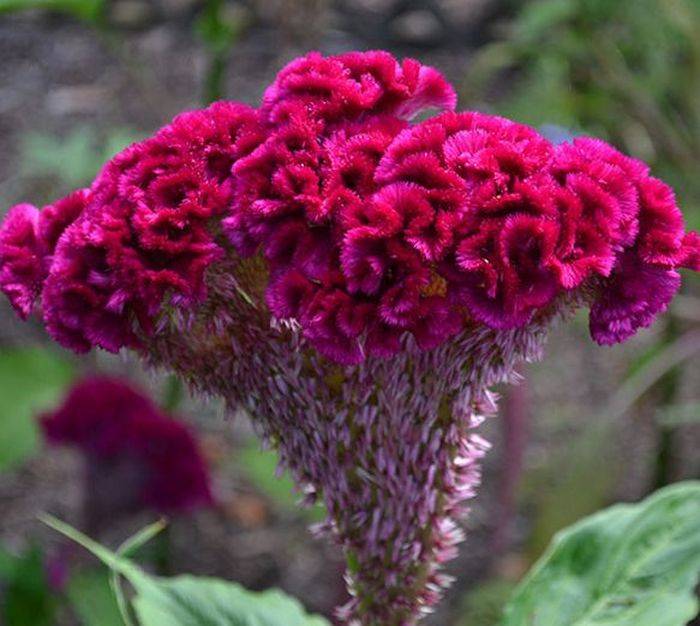

Celosia comb or cockscomb
Many flower growers are in love with this flowering herbaceous plant, so every year it becomes more and more popular. Now consider and remember how to plant correctly? You need to plant on rich, well-drained soil, which has already warmed up in the spring.
You can plant seedlings, those who live in warm areas can sow tiny seeds directly into the flower garden. In areas further north, plant only when the soil warms up before planting, otherwise, the plant itself may grow and stop flowering.
If you plan to grow cellosia outdoors from seeds, it is best to sow them in a partially shaded or sunny area of the garden until the last frost of spring. After the seeds are sown, they need to be slightly soaked, and the soil must be pre-prepared. In the fall, before planting cellosis, prepare the planting site by removing weeds and mixing organic matter into the soil.
Even sandy loam soils, considered ideal for most annuals, must have organic matter mixed each year to maintain a luxurious bloom. It is good to add aged cow dung, vermiculite and sand in equal parts. With increased acidity, lime is added.
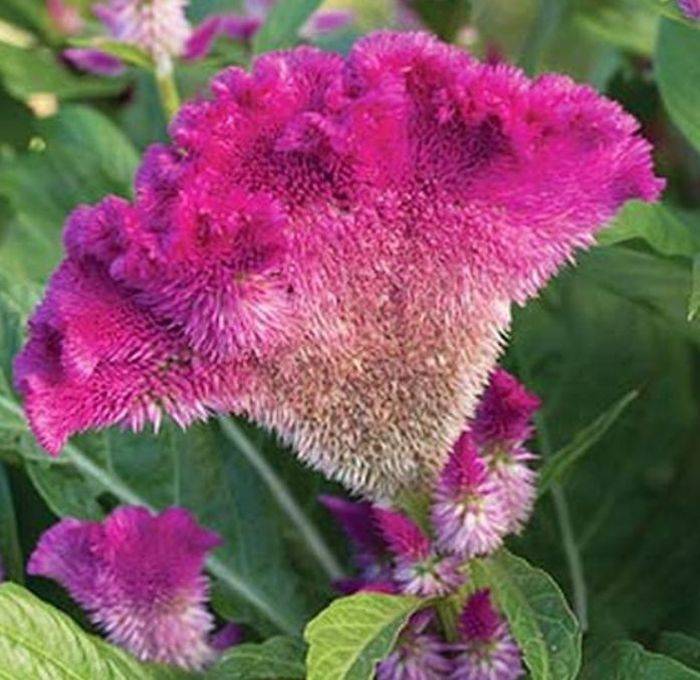

In the spring, sow at the end of March or April. To do this, make shallow grooves with a hoe and sprinkle the seeds not thickly, moisten them a little with water using a spray bottle. Cover with soil. If you are doing several rows, then you need to retreat 30-40 centimeters, or even more. From time to time, you need to moisten the crops until the first signs of obvious growth.
If you still decide to plant through seedlings, then it's a little troublesome. At the end of February, you can sow it in convenient trays. To do this, in fertilized soil, sow seeds in separate holes, or make indentations along the entire length of your tray. Sprinkle gently and sprinkle lightly with damp earth. After eight days, the first shoots will appear.
When leaving, you need to take care of them. When the sprouts are hardened, they must be dived into separate cups or right there in the tray. Also, make sure that there is normal freshness but without direct sunlight and moderate humidity. Cover the soil surface with a film, which is completely removed after the first shoots appear. To plant in the soil depending on the climate, in Crimea I plant after May 15, and where the soil has not yet fully warmed up, then plant later.
Mister summer resident recommends: the use of cellosis
Cellozia is used for medicinal purposes, by traditional healers and specialists. She is treated for gastrointestinal disorders. Used for the treatment and prevention of the mouth and throat.


Among the medicinal properties, the presence of an anti-inflammatory effect is also noted. To do this, the seeds are crushed in a coffee grinder, then poured with vegetable oil. As a result, celosium oil is obtained, it is used for redness of the skin, microcracks. Especially popular with women, it makes the skin velvety.
Application
Celosia silvery has various uses. In our climate, it is grown for decoration, depending on the variety, it can be grown in containers of all stripes, or in a flower bed. Larger varieties, like secondary plants. Growing cellosis for bouquets is comparatively less popular. In a vase, the inflorescences remain fresh for up to 14 days. Inflorescences for ikebana are cut much more often, since they retain their shape and color well in a dry bouquet. Provided that the leaves are cut off before drying and dried in a ventilated place under a canopy.
Almost all parts of the plant, except for the root, are used in medicine. In particular, this includes Indian medicine, commercial European medicine uses the plant more often, as research confirms the properties proven by traditional medicine.
At the moment, young shoots and leaves of specially prepared varieties are common food for the entire tropical zone of Africa.
Content
- Listen to the article
- Description
- Growing cellosis from seeds Sowing seedlings
- Seedling care
- When to plant
- How to grow
- How and when to collect seeds
- Celosia silvery comb
Celosia after flowering
Seed collection
To get cellosis seeds, you should pick several pieces of inflorescences that have begun to fade. They are placed in a dry vase and removed to a gloomy place. After the inflorescences are completely dry, seeds need to be removed from them, for this they are simply shaken over a newspaper sheet. The seeds scattered along with the garbage must be blown out, and then poured into a box and put away for storage. If you wish, you can collect seeds in a different way. To do this, they are hung with inflorescences down, and a newspaper sheet is placed under them. After the seeds are dry and ripe, they spill out onto this leaf by themselves.
Wintering
As a rule, in the autumn, the remains of celloses are disposed of. However, if you wish, you can create dry bouquets from the inflorescences. To do this, you need to cut off several flowering inflorescences of a tall variety, remove the leaves from them and bring them into the room. They are tied in a bundle and placed in a well-ventilated, unlit room. Wait for the bright blooms to dry completely. After that, they are placed in a vase without water.
Gallery: celosia (60 photos)
Growing seedlings
In order for cockscombs to bloom earlier, it is better to grow them in seedlings. Reproduction by cuttings is possible, but the flower loses its decorative appearance.
When using method 1, you must adhere to the following rules:
- Seeds should be sown in March - April. You can either buy them or assemble them yourself.
- Before this event, the seed should be held for 2-3 hours in a warm solution of potassium permanganate.
- The land used for planting must be well moistened. It is better to use a mixture bought in a special store.
- When planting, the seeds should be placed at a distance of 2 cm from each other.
- They need to be lightly crushed into the planting soil.
- Containers with seedlings should be covered with a transparent film and placed in a warm room.
- When seedlings appear (5-7 days after planting), the film must be removed and the seedlings must be placed in the sun.
- Plants require moderate but regular watering.
If there is little light in the room, then it is better to install a backlight.
After the appearance of 2 real leaves, you can start picking into glasses made of peat or plastic. If the plants are very elongated, then when performing this procedure, the stem should be immersed in the ground to the leaves. It will get shorter but stronger. The root system will be more powerful.
Advice! You can plant seeds directly in cups to avoid diving.
Thus, growing scallop seedlings is not difficult. You just need to follow the experience accumulated by gardeners.
Post quote from Stlani Cockscomb. Celosia
Celosia, Latin - Celosia. The name comes from the Greek word 'kelcos' - burning, fiery and associated with the color of the leaves and flowers. Velvety exotic inflorescences of a variety of celosia look great in the most exquisite flower arrangements, coloring our gardens.
Amazingly beautiful undersized potted celosia are an elegant decoration of the sunny loggia and balcony.
The genus includes up to 60 species originating from South China, East India, Africa and America.
Celosia paniculata in Nigeria has a complex name that translates as "a plant that makes husbands fat and happy." Its broad leaves are traditionally eaten in West and Central Africa. In the traditional medicine of China, celosia seeds are a valuable medicinal raw material, here they are used to prepare medicinal and health-improving teas.
Feathery, or plumose celosia (Celosia argentea f. Plumosa), is crowned with an inflorescence in the form of a dense or loose, large panicle, resembling either a plume or a miniature fire flame. Perhaps it was she who gave the name to the whole species, because in translation from Greek the word kelos means "burning", "flaming."
Another form, cetaceous cristata, or cristata celosia (Celosia argentea f. Cristata), is popularly called "cock's comb". Its unusual form of inflorescence arose as a result of a rather rare phenomenon in botany - fasciation, that is, the growth of the upper part of the peduncle. All its branches have grown together, forming a wide, winding receptacle in the upper part, on which numerous small flowers are located tightly to each other.
The wild ancestors of this celosia come from Southeast Asia and Africa. Where exactly she came to Europe, it is difficult to say: some botanists believe that from India, others - from Africa. It is known for certain that this happened in the second half of the 16th century, and the plant then immediately became very popular among gardeners.
Among the forms and varieties of silver celosia, there are giants up to a meter high with very large inflorescences and dwarfs only 10–20 cm tall, whose inflorescences, gracefully framed by leaves, seem to lie right on the ground. Flowers in both forms can be light yellow, almost cream, orange, pink, crimson, salmon, red, burgundy. But in whatever colors and shades the inflorescences are painted, they are always surprisingly bright, burning, as if phosphorescent.
Perennial or mostly annual herbaceous plants with straight, juicy, ribbed stems of green color, often with a red tint, 30-70 cm tall. The leaves are arranged in the next order, whole, petiolate, smooth, ovate with a pointed end, green, variegated or dark purple. The flowers are small, bisexual, with brightly colored membranous bracts, collected in large, original comb or paniculate inflorescences. The fruit is a rounded box. Seeds are round, shiny, black. There are 700-800 pieces in 1 g, which remain viable for up to 5 years.
Celosia inflorescences are divided into three main groups in shape:
- spikelets
- feathery
- comb
Most often cultivated cessation comb and feathery celosia.
Care
Celosia captivates not only with its beauty, but also with its simplicity of cultivation. Celosia is easy to grow from seed. They are sown for seedlings in the first half of April. Seedlings dive into pots, because the plant does not tolerate transplanting in open ground. In early June, when the threat of frost has passed, the seedlings are planted in a permanent place.
The soil is preferable fertile, loose, structural, non-acidic. It is advisable to choose a place protected from the wind, warm, sunny and without stagnant water. The distance between plants depends on the variety and ranges from 15 cm for low varieties to 30–35 cm for tall ones. Good watering is required during the initial growth period. Top dressing with full mineral fertilizer is done every 10-15 days. If you overfeed plants with nitrogen and organic matter, they will grow powerful, but they will not bloom well.
Celosia is planted in flower beds, in ridges, borders. It grows well in containers, on balconies and window sills. Flowering - from late June to frost.
Reproduction
Reproduction of cellosis is not difficult. Basically, celosia is propagated by seeds, since during cuttings the decorative effect of plants is sometimes lost. Sow seeds of cellosis for seedlings in March-April under a film. They are rarely sown on the surface of moist soil.It is advisable to sow cellosis immediately in separate pots so as not to damage the root system of plants when picking. The first shoots appear in 4-6 days.
It is better to buy seeds of a mixture of varieties, and then the motley cheerful celosi will color your balcony and garden for a very long time - all summer and the warm part of autumn.
Celosia seedlings are grown at moderate room temperature (17-20 ° C), with good lighting and ventilation.
The main thing is moderate and careful watering. It is important not to overdry the soil and not flood young plants, since the roots of cellosia seedlings easily rot from excessively moist soil. It is necessary to grow seedlings of celosia on a bright window, protecting from the hot sun.
Transplanting grown and acclimatized plants into open ground is carried out only after the end of the spring cold. After all, celosia is very thermophilic and does not tolerate even the slightest frost!
Between dwarf varieties, the distance between plants is 10-15 cm; larger plants are planted every 20-30 cm.
The best place to plant celosia in the garden is sunny, sheltered from the cold wind. The soil is desirable loose, slightly acidic, well-drained.
Fertilizing with mineral fertilizers is carried out once a month. Celosia responds very well to fertilization with lush flowering.
On hot and dry days, abundant watering is necessary, otherwise they will lower the leaves and do not form new peduncles.
Note for lovers of dried flowers and winter bouquets: celosia is perfect for floral arrangements!
Celosia inflorescences for a long time perfectly retain their "foppish" shape and model. They do not lose color if cut before seed ripening and dried well in a dark, cool room for two weeks.
4. Varieties and types
Celosia silvery comb (Celosia argentea), or Cockscomb.
Perennial up to 45 cm high, cultivated as an annual. The elegant varieties have a compact bush, reaching a height of 20-35 cm. Small flowers of Celosia comb are collected in a spectacular massive inflorescence with convolutions along the upper edge. The shape of the inflorescence resembles a cock's comb.
The color of the flowers of comb cellosia is yellow, pink, orange, purple-red. Such bright colors and unusual shape of inflorescences are rarely found among other plants.
Therefore, a flowerbed with a comb-shaped plant invariably attracts admiring glances.
Celosia comb blooms from July to October.
However, the decorativeness of plants after flowering is not lost. After all, the leaves of various varieties of comb cellosia are not only green, but also dark red, burgundy, purple, bronze, golden.
Variety "Impress" has a red inflorescence and purple leaves.
The "Imperialis" variety (20-25 cm high) has beautiful dark red shoots, purple leaves with red veins, dark purple inflorescences.
Variety "Atropurpurea" is of the same height, has a pinkish stem with light green leaves; large purple-red inflorescences.
Comb cellosis is used for planting in flower beds, flower beds, flowerpots and as a summer pot culture. This ornamental plant also looks great in combination with other annuals.
Silver feathery celosia (Celosia argentea).
An annual plant up to a meter high. Feathery celosia blooms for a long time and magnificently for many months, without losing its decorative effect until autumn frosts.
Spectacular varieties of pinnate celosia form a compact bush with bright paniculate inflorescences. The length of the inflorescences is usually half or one third of the height of the plant. Dwarf (20-30 cm), medium-sized (30-50 cm) and tall varieties (50-90 cm) have been bred.
The color of the stems, leaves and inflorescences in the pinnate cellosia is very diverse.
Dwarf mix "Geisha" (height 20-25 cm) forms charming panicles of inflorescences of rich colors. This luxurious mixture is very good for potting.
Another dwarf multi-colored mixture - "Baby"
Variety "Goldfeder" (height 25-30 cm) adorns the balcony and garden with paniculate golden-yellow inflorescences, as if emitting light.
Variety "Feuerfeder" (height 35 cm) has greenish-pink shoots and light leaves with pink veins, the inflorescence is bright red.
The variety "New Look" (height 35-40 cm) strikes with the contrast of purple-violet foliage with a metallic sheen and scarlet brooms.
Variety "Golden Flitz" (height 80 cm) against the background of light green leaves forms a golden-orange inflorescence.
Variety "Tomsoni Magnifica" (height 60-80 cm) has greenish-pink stems and leaves, burgundy pyramidal inflorescences.
Celosia pinnate is used in flower beds, groups, for single plantings and for bouquets. Dwarf species are used for growing in pots, for decorating a sunny balcony.
Celosia spikelet.
Spikelets are less popular with flower growers, but in vain!
Inflorescences in plants of this group are very similar in appearance to ears of wheat - hence the name.
The color of flowers in spikelets is also varied - from white to purple. Bright, showy inflorescences go well with narrow green leaves.
Depending on the variety, the height of plants ranges from 20 cm to 1.20 m. By the way, it is the spikelet group of celosium that is the ancestor of garden forms.
Celosias are valued for the originality of bright inflorescences and decorative leaves. Good in containers and flowerpots. Recommended for flower beds, flower beds, vases, dry bouquets.
Celosia is an unpretentious flower from the Amaranth family, a perennial plant grown as an annual. Silver celosia is the best decoration for flower beds and a bed of your garden. Celosia is also grown in pots and flowerpots at home.
The homeland of silver celosia is hot Africa, Asia and South America. More than 60 types of celosia are known, however, in gardens, greenhouses and indoor gardens, silver crested celosia and spikelet celosia (Hatton's celosia) are most often grown.
Hundreds of varieties of celosia, bred by breeders around the world, will not let you get bored of the monotony. In this article, I will give examples of just a few varieties of cellosi that are most often sold in stores. You can try exotic varieties of cellosi on your own if you enjoy growing it.
By the way, the people do not know the scientific name of silver celosia - they simply say: cock's comb or cockerel. A rare gardener asks for cellosis in a store, and the sellers know that a cockerel or a scallop is cellosis. Therefore, it is enough to remember for yourself the "flower cockerel" and the trick is in the bag - you can go for the seeds.
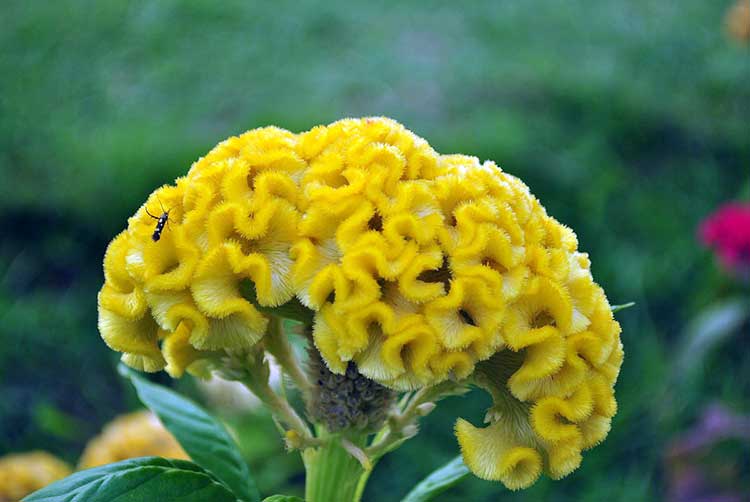

Yellow inflorescences of celosia look spectacular in any environment. Pictured is Celosia cristata. Source: Wikipedia
Scallops bloom from early July until the first frost and abundantly set seeds, but the seeds do not fully ripen.
Comments (2)
Alexandra
03.06.2019 at 21:25 |
I first saw celosia when I was almost thirty years old. It doesn't grow on the streets, but one employee brought it to work from home. We all marveled at such beauty then. I tried to grow at home, and for some time it bloomed with me, but then it died.Reply
Julia Expert Plodogorod
04.06.2019 at 23:06 |
Hello Alexandra! Let's take a closer look at the features of caring for this plant, as well as the likely causes of the death of the flower, in order to prevent the recurrence of problems in the future.
The planting site should be sunny, protected from wind and draft. Celosia prefers loose and slightly acidic soils. If the site is heavy and dense soil, it is better to add sand and peat to it. In addition, it is better that the soil is pre-fertilized. We recommend using rotted compost for this. It will also make the soil looser, not just nutritious.
It is better to plant a flower in the first days of summer.If the seedling method was used for cultivation, be sure to systematically weather and temper the seedlings. You can start with a few hours on a balcony or veranda, and then, just before transplanting into open ground, you need the flowers to fully spend the night on the street several times.
Planting from containers with seedlings is best done by the transshipment method in order to less injure the rhizome. This plant does not bloom well if it lacks moisture. Also, feeding with complex mineral agents will not be superfluous.
The most common problem with this plant is the blackleg fungal disease. Seedlings or recently planted specimens are most often affected. But adult flowers are not immune from this either. Such a disease manifests itself as dark spots at the base of the stem. Over time, the site becomes soft and dies off.
To avoid such difficulties, it is worth using non-cold water when watering seedlings. And besides, disinfect the soil before sowing seeds and transplanting adult plants. This can be done with a manganese solution or some kind of drug, for example, Fitosporin.
Also, we do not recommend thickening the planting. The distance between seedlings in the seedling container should be at least 5 centimeters. Adult bushes are planted at a distance of 30 centimeters.
Fungal diseases can arise from excess watering and stagnant moisture. So that this does not happen, it is necessary that the watering is slow, then the moisture will have time to be absorbed. In addition, it is worth observing the requirements for soil looseness, and laying a drainage layer in the planting hole.
Reply
Celosia care
When leaving comb cellosis, you must remember the basic rules:
- Avoid temperature extremes, drafts, wind and stagnant water.
- Drizzle with warm water and preferably early in the morning. Strong moisture can lead to root rot.
- Feeding with organic fertilizers twice a month throughout the growing season, overfeeding is also not permissible, since all the strength will go to the development of leaves and you will be left without beautiful flowers.
- Timely remove weeds around the bush and loosen.
How to grow cellosis from seeds (video)
We also recommend reading:
16 of the most popular indoor plants Physalis: description of species and varieties, technology of growing from spruce seeds in landscape design: the best decorative varieties and features of growing Kalanchoe: description of species and features of care at home
Cockerel flowers
Cockerel flowers, or as they are also called - Iris, belong to the genus of perennial plants Iris or Iris. More than 700 varieties of these beautiful flowers are known, which amaze with the amazing shapes of the buds and the variety of colors.
Irises are rhizome and bulbous. Also, the plants differ in the shape of the buds, there are bearded ones, which are usually called cockerels because of the characteristic crest, and non-beard ones: marsh, Siberian, iris spuria.
Leaves most often have a xiphoid shape, thin, elastic, covered with a waxy bloom, less often linear leaves are found. They gather in bunches around the peduncle.
Large single buds can be of various shapes and all kinds of colors, some have a light pleasant honey aroma. Flowering begins in late spring and lasts until July, and some varieties bloom again in September.
Celosia photo
Celosi features
The herbaceous plant celosia is represented by perennials and annuals; there are also shrubs. In mid-latitudes, this flower is cultivated as an annual because it is not able to survive the frosty winter. Shoots are branched and straight. Alternate leaf plates have an ovate-lanceolate, ovoid or linear-lanceolate shape.Crested, paniculate, or spike-shaped inflorescences consist of small flowers that can have different colors, for example: pink, orange, golden, yellow, red or scarlet. The fruit is a polyspermous capsule.
Where to plant them
As with planting any perennial, you need to think about where it is best to plant the plant. To do this, you need to know that irises tend to move several centimeters annually from their original place and grow rapidly.
Light and place
A large amount of light is the key to success in growing scallops, with good lighting you will get the maximum flowering in size and duration.
In shaded areas, the plant feels uncomfortable and may not bloom at all. It must be borne in mind that excessive moisture is undesirable for these flowers, therefore high flower beds, areas on slopes and hills are best suited for planting. In this case, plants should be protected from strong winds and drafts, since if they are present, the stems can break off.
The soil
Irises prefer neutral or slightly alkaline soil; when planting in acidic soils, it is imperative to add lime, chalk or ash to neutralize acidity.
To plant bearded species, it is necessary to make good drainage, since stagnant water can greatly harm the plant. Before planting, the soil must be well loosened and all weeds removed. Fertile, rich soils are ideal for planting.
Propagation of cellosis
The seeds are harvested from dried flowers. The inflorescence is simply rubbed over the paper and the seeds spill out on their own. Before sowing, they need to be dipped in a solution of epin and zircon for three hours (drop by drop per 200 ml of water). It is better to sow cellosia in March in a mixture of vermiculite and humus earth. It is necessary to sow rarely, without covering the seeds with earth, you should just press them down and sprinkle with water. Next, the container is covered with glass and kept in good lighting conditions (diffuse) and a temperature close to 25 degrees. Ventilation is performed from time to time. In the interval from a week to ten days, seedlings appear. If a lot of seeds are sown nearby, then it is necessary to make a dive into shallow containers (depth up to 5 cm). When the seedlings take root, you need to start fertilizing with a solution of mineral fertilizing (but you need to dilute it more than indicated on the label). When the celosia grows a little more and gains strength, then it can be planted in permanent pots. After some time, after the second pick, when the plants have already taken root, you will need to start fertilizing again.
Plant varieties
The most cultivated varieties or types of cellosis:
- Celosia paniculata (silvery pinnate celosia) has lush inflorescences, tall varieties reach a meter in height, the color of various parts of the plant can be very diverse.
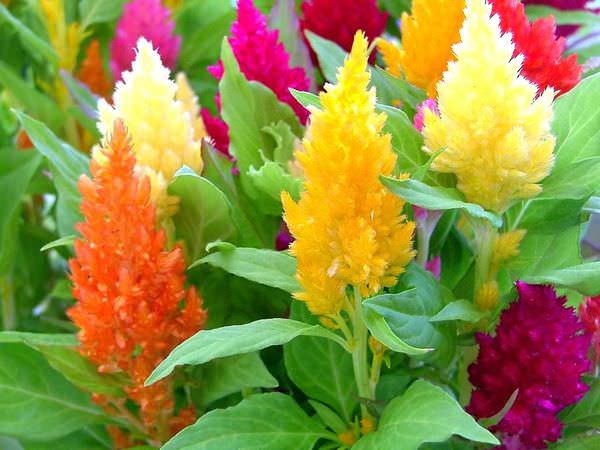

- Celosia cristate silvery - The flowers of this plant variety form an inflorescence that is very reminiscent of a cock's comb.
- Spikelet celosia - is cultivated much less often, but is deprived of attention in vain. Its inflorescences resemble spikelets. The colors are very different.
All types of plants are original, beautiful, and can become an attraction in any area.
How celosia combines with other plants
This plant is beautiful, bright, hardy, which ensured its popularity. In principle, it is considered self-sufficient, so if there is no desire, it does not need to be mixed with other colors. But if it is nevertheless decided to do this, you can mix celosi with literally all annuals.
- If you are growing a crested cellosis, it will be balanced by calmer and simpler flowers.
- If celosia is a bright accent, other flowers should be slightly muted.
- The yellow-orange tones of paniculate cellosia are perfectly combined with the blue-violet Mexican aggregatum.
- Two-color groundwort is an excellent "companion" of celosia.
- White labelia will be a beautiful background for red cellosis. The same sort of cellosi goes well with ornamental cereals. However, do not forget that if the care of plants is different, you will have to follow its principles in relation to each to the right degree.
Care features
Growing celosia in your garden is quite simple, but you should take into account several nuances. Seedlings planted in open ground and caught even under a slight frost can die. And this plant also reacts negatively to waterlogging of the soil. When caring for the target, it is imperative to take into account these nuances. Watering should be done only with prolonged drought and heat, while the leaves of the bush should drop and new peduncles should stop growing. Do not forget to feed these flowers once a month, but at the same time, nitrogen-containing fertilizers for this purpose should be used with great care, because if you overfeed the cellosis, it will stop blooming, but its foliage will be very thick. Also, do not forget to systematically loosen the soil surface around the bushes and weed.
How to prepare seeds before planting
Despite their small size, the seeds have a very dense shell. It prevents them from germinating, so the germination rate may be low. It can be increased if, before planting cellosia, the seeds are soaked in a solution of Zircon or Epin. Thanks to these preparations, the seedlings will be stronger and more resistant to various diseases. What is needed for growing
Growing seedlings begins with preparation. You will need:
- ready-made soil mixture;
- wide capacity;
- glass;
- seeds;
- trowel;
- gloves;
- sprayer;
- boiled and cooled water;
- Epin (or another growth stimulant);
- vermiculite or sphagnum;
- a sheet of glass, a clear plastic bag, or a piece of greenhouse film.
You will need a toothpick for neat sowing. But many gardeners make their work easier and do without it.
Planting irises
There is no specific guide to when to plant irises; this can be done both in spring and autumn, taking into account certain nuances.
In the spring
Pre-planting should not be neglected. You should carefully examine the tuber and, if necessary, remove the areas on which rot has formed, and cut the roots that are too long.
Then it will not be superfluous to disinfect it in a solution of potassium permanganate, for this, mix the drug with water until a pale pink color and soak the planting material in it for 30-40 minutes.
This simple procedure will help to avoid further problems with the development of the plant. Another secret of successful planting is that the root can be kept for 30 minutes in a solution of "Karbofos", due to which the plant will create a stable immunity to pests. The depth of the planting hole for bearded species should be proportional to the tuber, it should not be buried too deep, the top should rise above the ground.
When planting non-bearded irises, the root should be carefully covered with soil. If you plan to plant several plants nearby, you must maintain a distance between them of at least 60 cm.
In autumn
In fact, the fall planting is not much different from the spring planting. It is also recommended to disinfect the roots and remove decaying areas. Let's call this hygiene procedures that will protect the plant in the future.
As for the depth and interval of planting irises, almost everything coincides with the spring. The only thing to consider is that the tubers should be planted mainly at the end of summer and maximum in the first week of September, so the plant will root well before the cold weather, and we will get the desired result.
Plant care after transplanting
After transplanting to a permanent place, the seedlings need intensive care. With poor watering, the plants will not produce new flower stalks.Therefore, they need a sufficient amount of moisture, especially during the hot period. Once every twenty days, the plants require feeding with special mineral fertilizers, which can be alternated with bird droppings.
Celosia should not be overfed, otherwise it will not grow flowers, but foliage. The plant does not tolerate low temperatures, the most favorable is 23-25 °.
Celosia blooms at home for a long time, but the room for this must be ventilated and must be well lit. In extreme heat, the plant must be sprayed. The higher the humidity and temperature of the air, the better the lighting should be.
General description of cellosis
The genus celosia includes approximately 60 perennial and annual plants, and belongs to the Amaranth family, although until recently it was referred to the Marevye family. Celosia can grow up to one meter in height, but each variety has its own exclusivity. High varieties of celosia pinnate are grown to decorate bouquets, and low varieties are grown in flower beds.
In order for the flower to grow well, good lighting is very important. The better the lighting, the longer, sometimes, until late autumn, celosia blooms.
This is how celion looks like:
- Stems of cellosia pinnate are straight and branched;
- The leaves are oval-shaped;
- The flowers themselves are small, and are collected in multi-colored inflorescences: yellow-red, golden-burgundy, etc.;
- The fruit is a polyspermous capsule.
Almost the only way to grow feathery cellosis in a flower bed is by seed. But before planting the seeds, their shell must be soaked, because it is too tight to germinate. This is done in a solution of Zircon and Epin, one drop in one glass of water.

